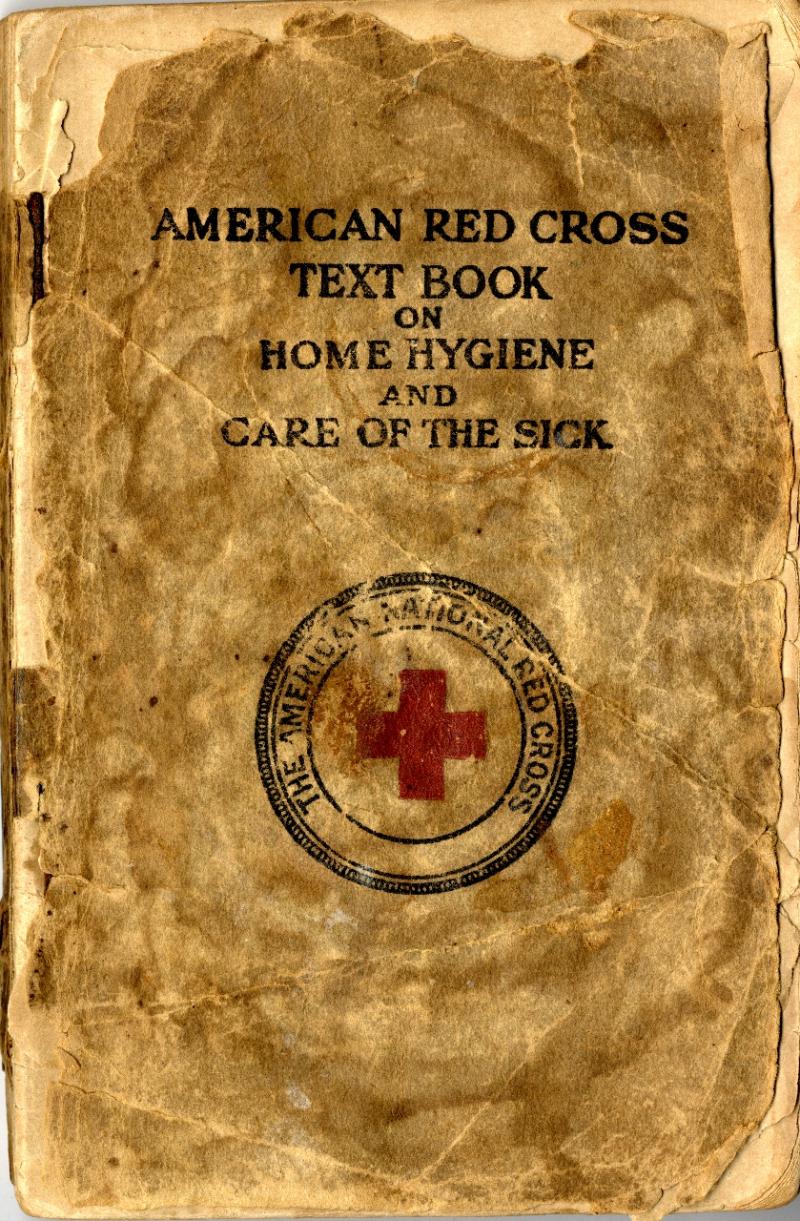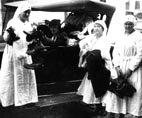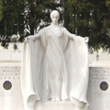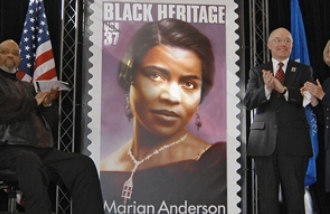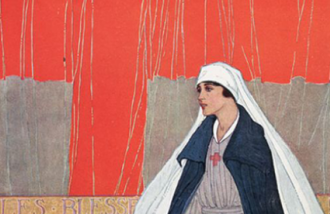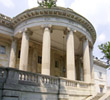Women of Resilience: DAR Service in World War I
Check out a lecture about the exhibit here
One hundred years ago, the United States of America entered World War 1. Although President Woodrow Wilson’s administration maintained a neutral stance during the early years of the conflict, Germany’s increased aggression towards the U.S. resulted in America declaring war on April 6, 1917.
Entry into the Great War elicited an extraordinary response from women across the country. Members of the DAR were no exception. Resilient women rose to the challenge, dedicating themselves to war relief activities that stretched from their living rooms to the battlefields of France, rendering service to their country worthy of their patriot ancestors. The DAR’s 26th Continental Congress commenced only ten days after war was declared. Sarah Mitchell Guernsey was sworn in as President General. A natural born leader, Mrs. Guernsey formed the War Relief Service Committee during her first week in office.
This exhibit honors the DAR members who selflessly and tirelessly dedicated themselves to the war relief effort. Their hard work and patriotic spirit contributed much to America’s victory. The accomplishments of selected DAR hidden heroes are highlighted. Featured are photographs, letters, bulletins, and scrapbooks from the NSDAR Archives.
Women of Resilience: DAR Service in World War I
“Every woman should take part individually in the campaign among American women for sufficient national defense which will insure peace and prosperity for this nation and enable us to stand up in the council of the nations a strong nation among the strong, and be a protecting friend of the weak. Our destiny is a high one as a nation, and the women of the country have as definite a duty today as they had in the time that tried the souls of men and women in 1776.”
- President General Story’s address to 25th Continental Congress, after President Wilson’s speech
On display: Photograph of President Woodrow Wilson attending Continental Congress at Memorial Continental Hall, 1916. (NSDAR Archives)
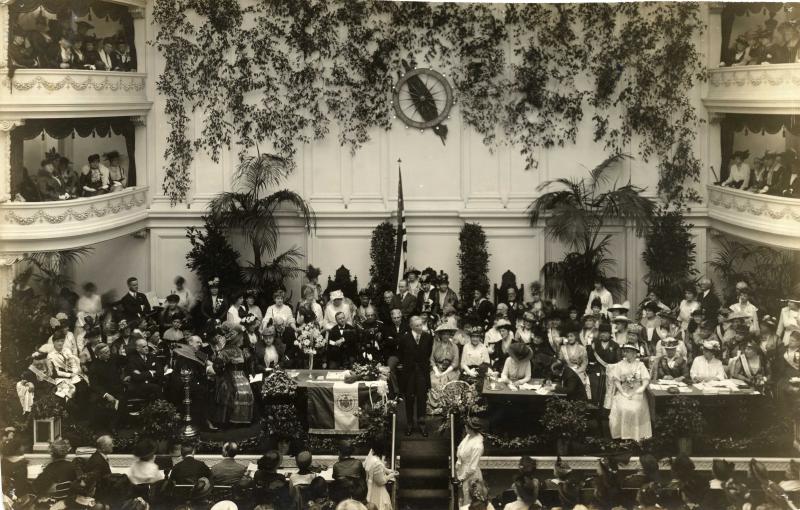
Women of Resilience: DAR Service in World War I
On display: War Time Pledge, circa 1917. (NSDAR Archives)
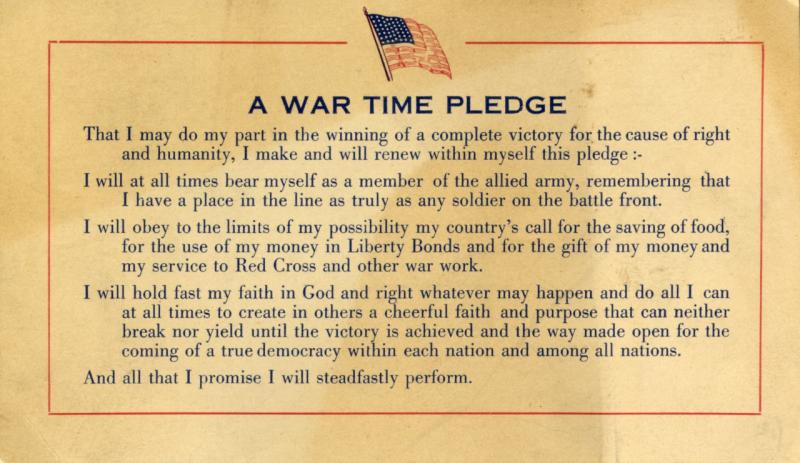
Women of Resilience: DAR Service in World War I
On display: Newspaper article “D.A.R. Enlists in War Relief Services” from the Letitia Green Stevenson Chapter (IL) Scrapbook, circa 1917. (NSDAR Archives)

Women of Resilience: DAR Service in World War I
“That the service of the home is not confined within the four walls of the house; that the service of the country is not confined within army posts or battlefields, even in war time; that the service of God cannot be bounded by the four walls of the church, but lies out in the open in our every-day lives – these are the Society’s deeper meanings which should inspire every Daughter of the American Revolution.”
On display: The Deeper Meaning of Our Daughters of the American Revolution Organization, 1918. (NSDAR Archives)
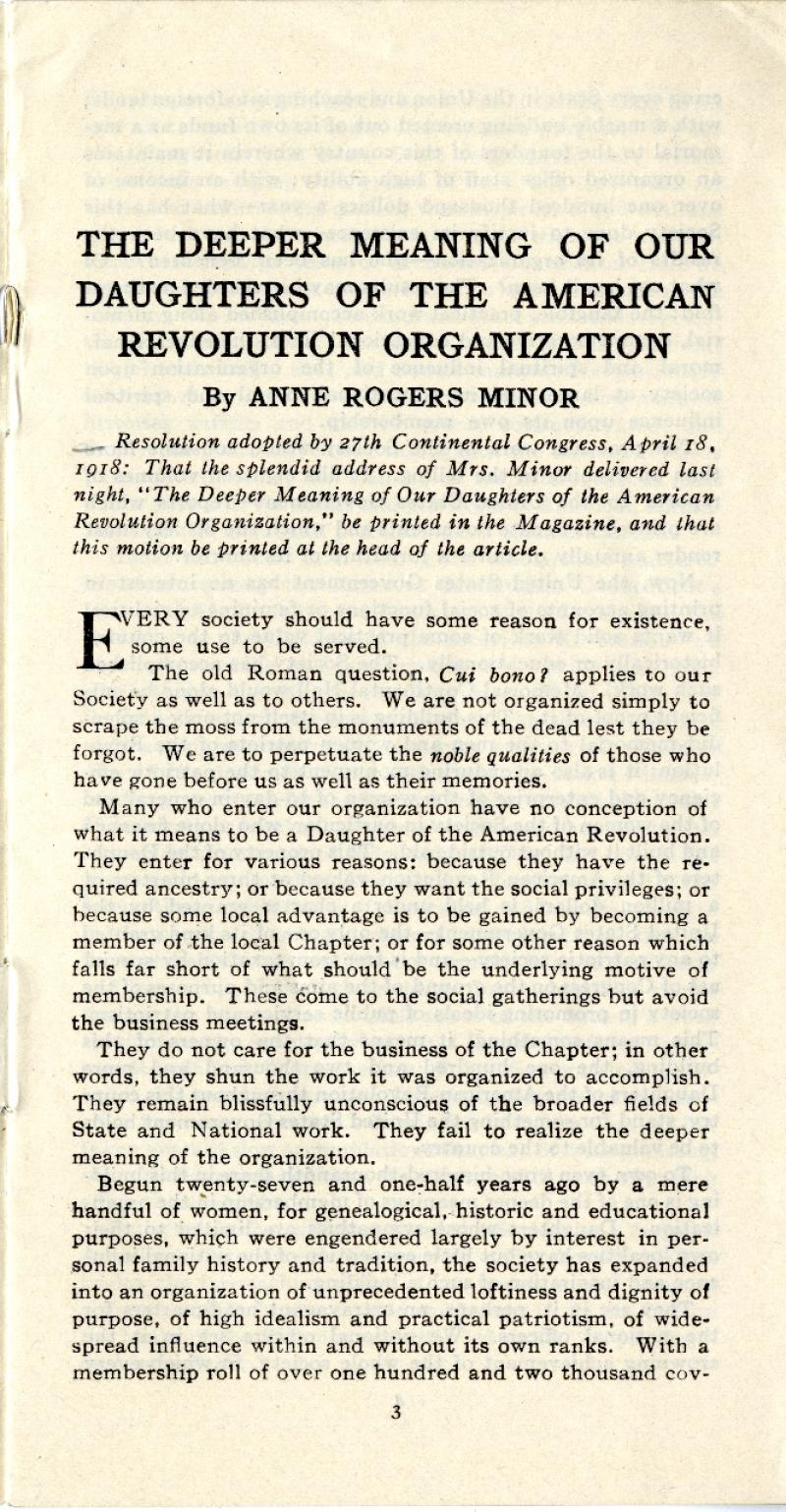
Women of Resilience: DAR Service in World War I
The War Relief Service Committee was a DAR National Committee formed to organize aid efforts during World War I. The Committee consisted of Chairman Julia Green Scott, Vice-Chairmen Adele Steiner Burleson and Mina Miller Edison, Director of Publicity Clara Hadley Wait, and Secretary Marie Wilkinson Hodgkins, with six district/division directors and vice-directors around the country to supervise the work. The Committee also called for the State Regents to form State Committees to cooperate with the National Committee and suggested that each Chapter begin a fund for war relief activities.
On display: Photograph of the War Relief Service Committee, South Portico of Memorial Continental Hall, from Clara Hadley Wait’s Scrapbook, 1917. (NSDAR Archives)
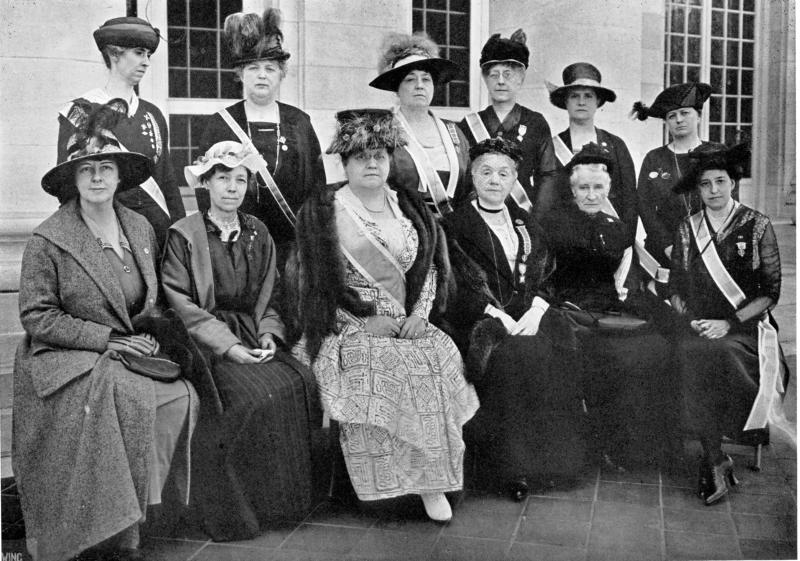
Women of Resilience: DAR Service in World War I
Julia Green Scott
National Chairman of War Relief Service Committee
President General Guernsey appointed Honorary President General Julia Green Scott National Chairman of the War Relief Service Committee. Mrs. Scott was a key figure in building DAR’s hand-in-hand relationships with other relief organizations. At 77 years of age, she took on the task of leading the committee, coordinating and communicating with the Daughters regarding their war-time service. She was able to achieve this by working closely with the Committee’s Director of Publicity, Clara Hadley Wait. Together, they collaborated with the state regents to do the work required of their states, and encouraged their chapter regents to reach individual members.
On display: Photograph of Julia Green Scott, no date. (NSDAR Archives)
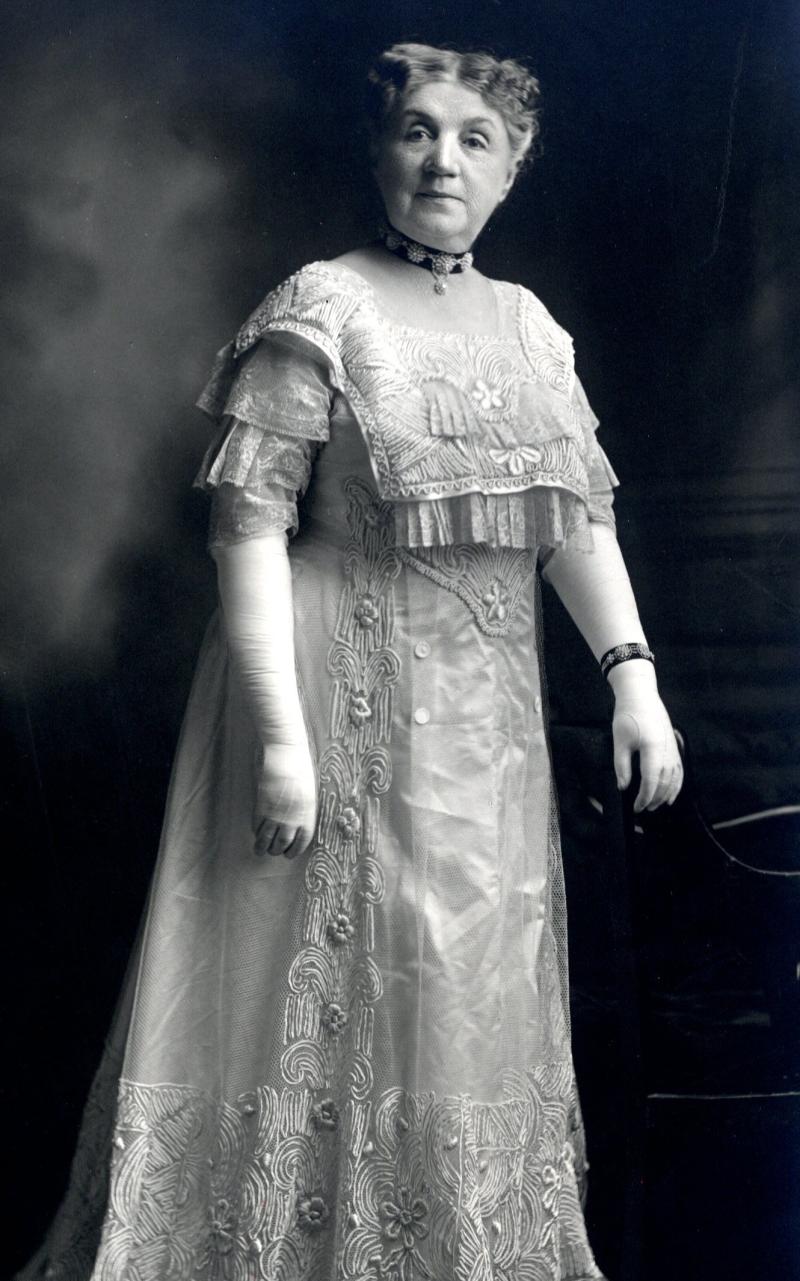
Women of Resilience: DAR Service in World War I
On display: Firsthand account from the Orange Mountain Chapter (NJ) Scrapbook, 1917. (NSDAR Archives)
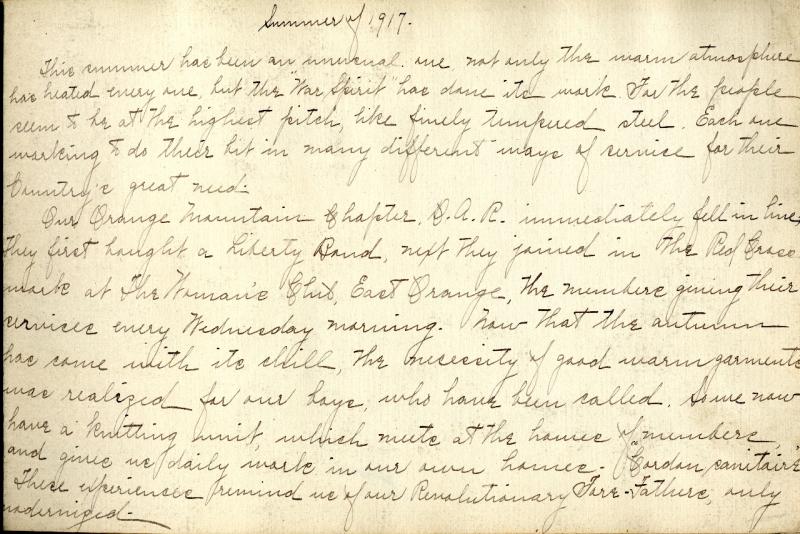
Women of Resilience: DAR Service in World War I
On display: Firsthand account from the Orange Mountain Chapter (NJ) Scrapbook, 1917. (NSDAR Archives)
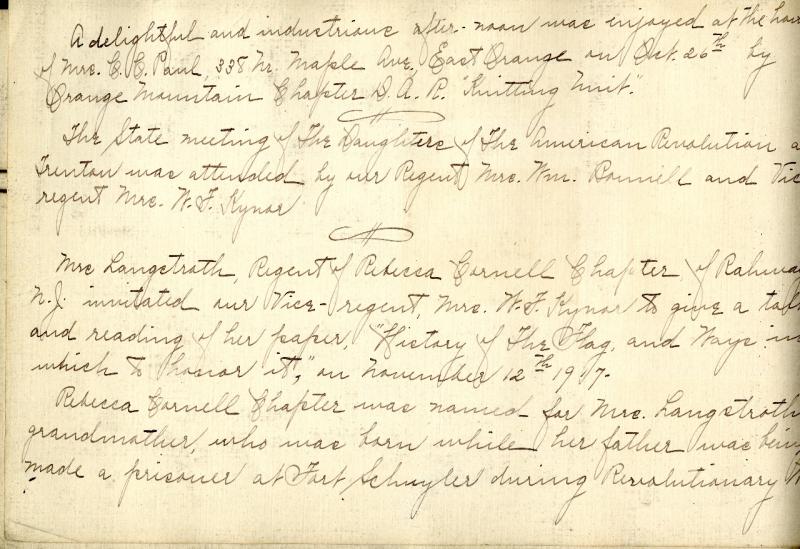
Women of Resilience: DAR Service in World War I
Clara Hadley Wait
Director of Publicity of War Relief Service Committee
The prominent voice of the War Relief Service Committee was Michigan State Regent, Clara Hadley Wait. Besides leading her own State, her service in this position greatly impacted all of the DAR’s volunteer service efforts during the war. On behalf of the committee she issued 100,000 registration blanks to DAR members to survey the skills and services they could pledge. The information from these forms helped catalog resources for both the National Society’s and the U.S. government’s war efforts.
On display: Photograph of Clara Hadley Wait, from Clara Hadley Wait’s Scrapbook, no date. (NSDAR Archives)
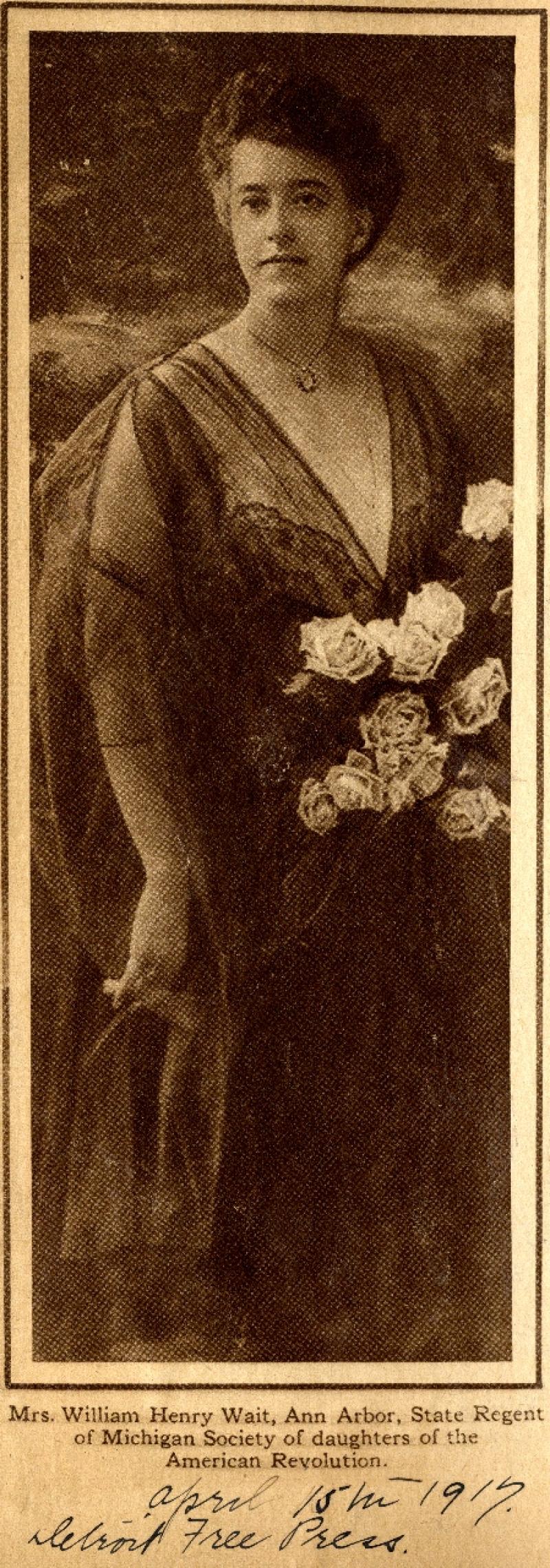
Women of Resilience: DAR Service in World War I
Mrs. Wait wrote bulletins that were distributed to every chapter and read during their meetings. The bulletins were republished by newspapers around the country and used by the U.S. government through the Committee of the Council of National Defense. Copies were requested also by the Bureau of Public Information, the National YWCA, the National Committee of Patriotic Societies, and the press.
Throughout the war, Mrs. Wait compiled a record of the relief work the Daughters had completed. Bulletin No. 17 is a sample of the extent of the work completed by the DAR chapters and state societies during the first year of America’s involvement in the Great War.
On display: War Relief Service Committee Bulletin No. 17, “Summary of War Work from June 21, 1917 to October 1, 1917.” (NSDAR Archives)
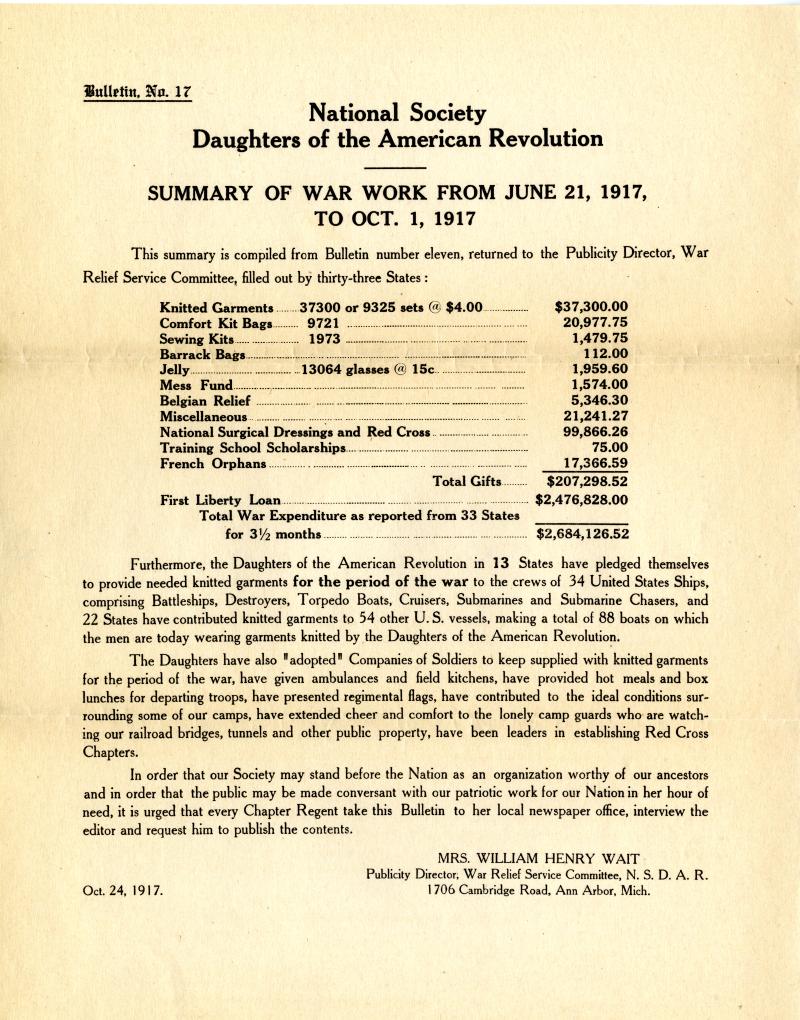
DAR Raises Funds
With the war in full force, the U.S. government was not prepared for the costs involved and needed additional funding from its citizens to guarantee victory. Funds were needed for feeding, training, and equipping the troops with munitions. The War Relief Service Committee encouraged DAR members to help finance the war through the purchase of Liberty Loan war bonds.
Chapters around the country gave up everything they thought was too frivolous in wartime – gone were the social events and extravagant refreshments. The accumulated savings funded war relief activities and the purchase of war bonds. Money was raised in myriad ways. Members held benefit concerts, rummage sales, and other events. They also made and sold flags, and donated unwanted precious metals to communal melting pots.
DAR Raises Funds
In 1917, the National Society loaned its home to the war cause rent-free. The National Council of Defense erected temporary quarters on the land behind Memorial Continental Hall where the Administration Building and Constitution Hall stand today. The government buildings remained on DAR property until 1921.
On display: Aerial photograph of DAR Headquarters during World War I, from the Rufus King Chapter Scrapbook, circa 1919. (NSDAR Archives)
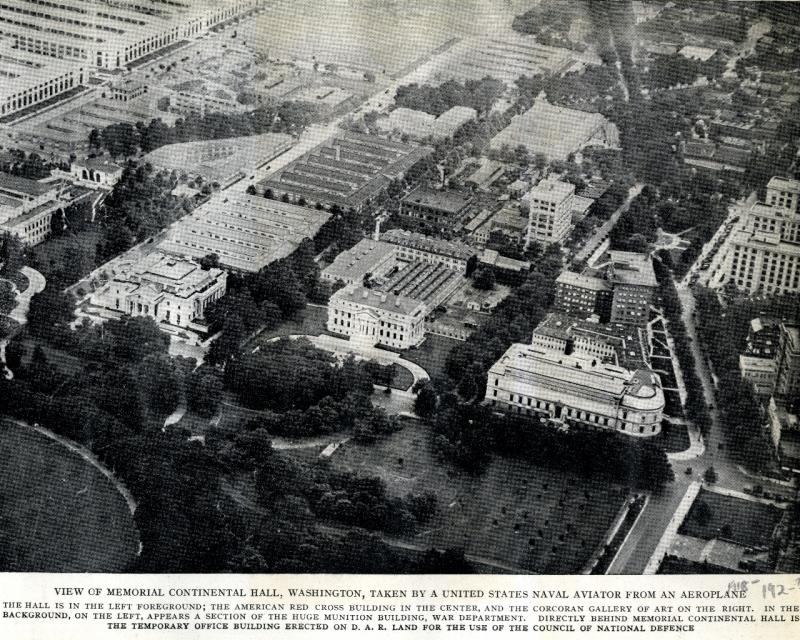
DAR Raises Funds
The DAR’s largest financial contribution to war relief, both in terms of funds and national importance, was its donations to the four Liberty Loans and the final Victory Loan. These war bonds supported the U.S. government’s cause in the war and subscribing to them became a symbol of patriotic duty.
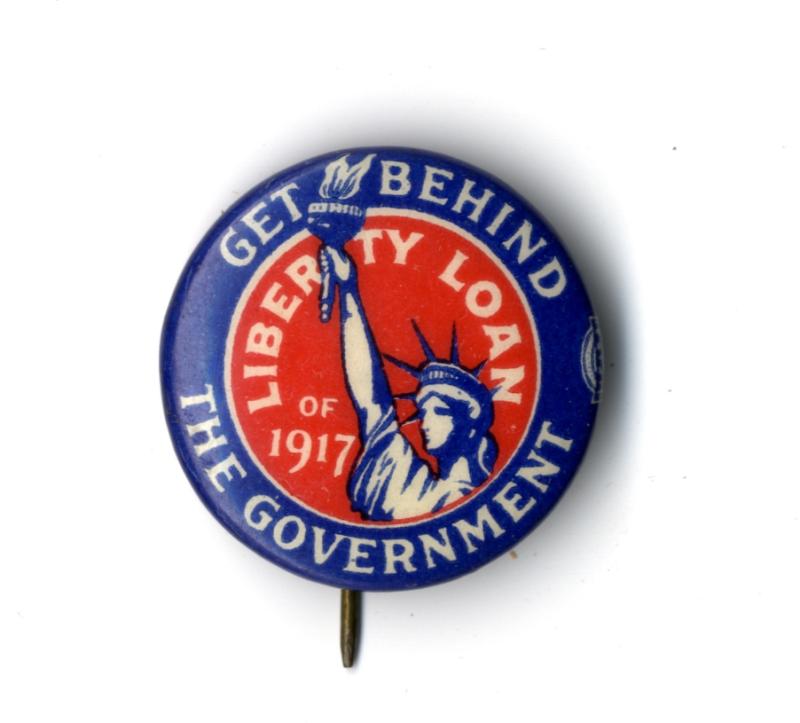
DAR Raises Funds
The DAR’s largest financial contribution to war relief, both in terms of funds and national importance, was its donations to the four Liberty Loans and the final Victory Loan. These war bonds supported the U.S. government’s cause in the war and subscribing to them became a symbol of patriotic duty.
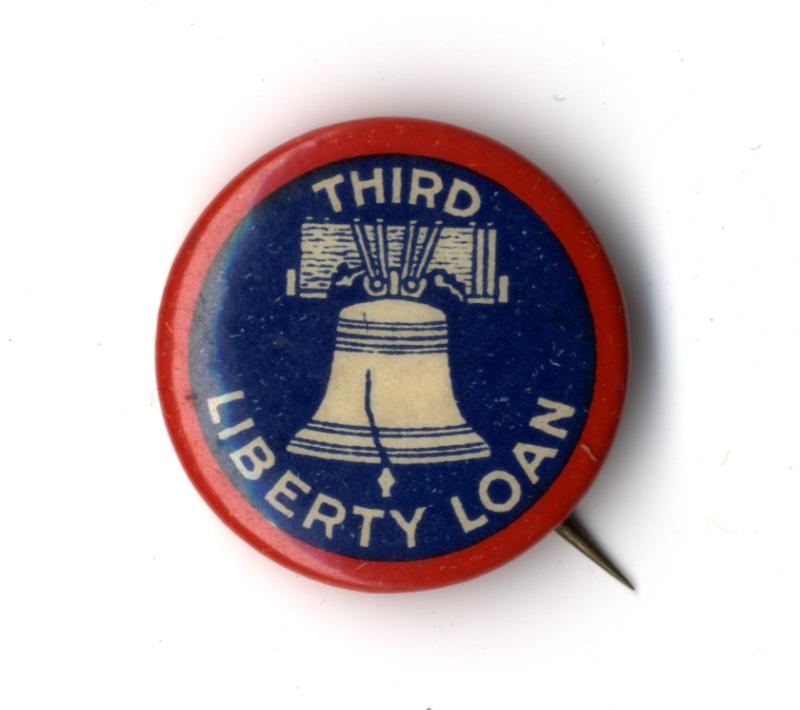
DAR Raises Funds
The DAR’s largest financial contribution to war relief, both in terms of funds and national importance, was its donations to the four Liberty Loans and the final Victory Loan. These war bonds supported the U.S. government’s cause in the war and subscribing to them became a symbol of patriotic duty.
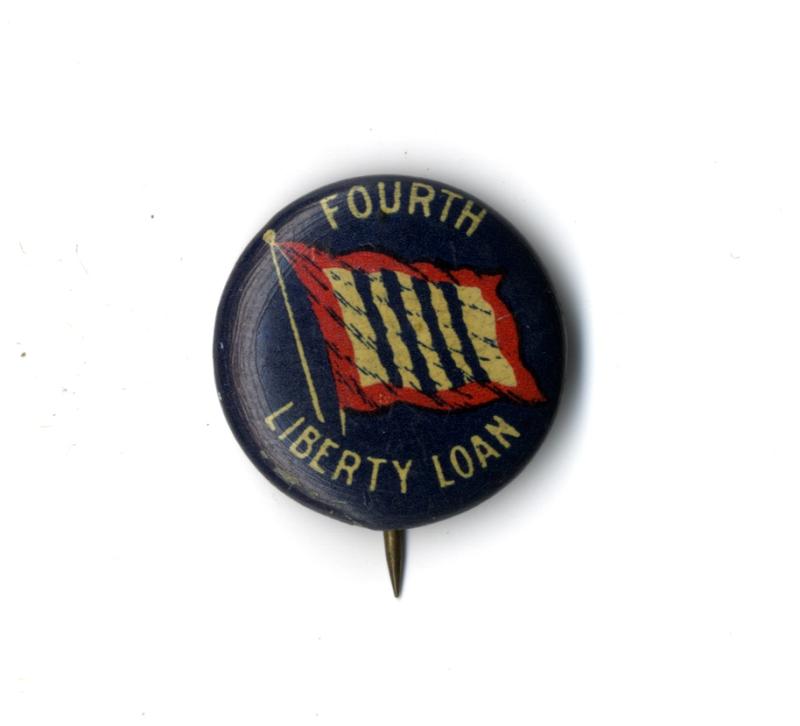
DAR Raises Funds
The DAR’s largest financial contribution to war relief, both in terms of funds and national importance, was its donations to the four Liberty Loans and the final Victory Loan. These war bonds supported the U.S. government’s cause in the war and subscribing to them became a symbol of patriotic duty.
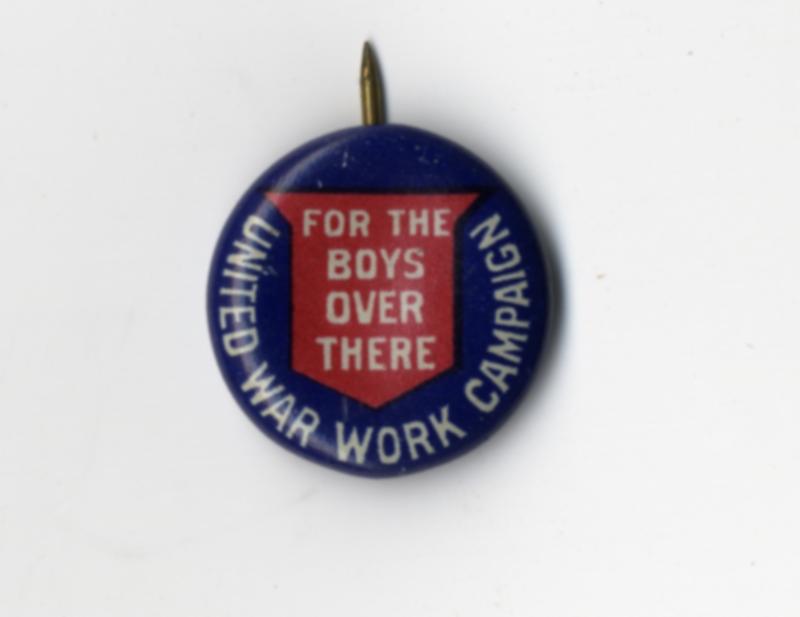
DAR Raises Funds
The DAR’s largest financial contribution to war relief, both in terms of funds and national importance, was its donations to the four Liberty Loans and the final Victory Loan. These war bonds supported the U.S. government’s cause in the war and subscribing to them became a symbol of patriotic duty.
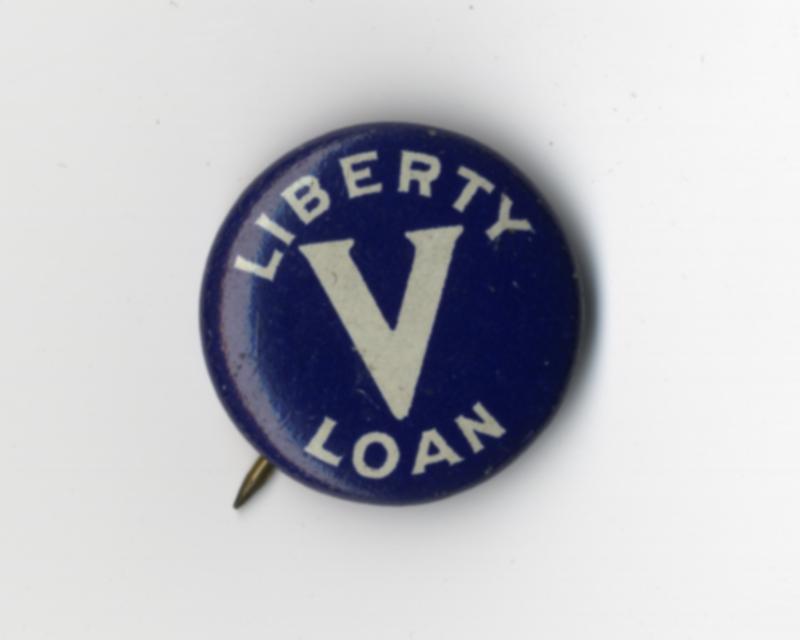
DAR Raises Funds
The DAR’s largest financial contribution to war relief, both in terms of funds and national importance, was its donations to the four Liberty Loans and the final Victory Loan. These war bonds supported the U.S. government’s cause in the war and subscribing to them became a symbol of patriotic duty.
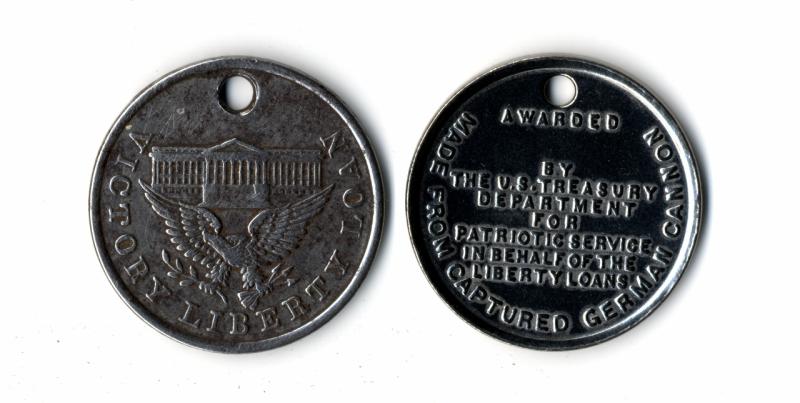
DAR Raises Funds
On display: Navy blue Continental Congress ribbon with lettering: “Connecticut Women’s Liberty Loan Committee of New England Authorized Worker The Fighting Fourth,” circa 1917-1919. (NSDAR Archives)

DAR Raises Funds
Sarah Elizabeth Mitchell Guernsey
President General of National Society Daughters of the America Revolution
The U.S. Secretary of the Treasury, William Gibbs McAdoo, selected Mrs. Guernsey to be a member of the National Woman’s Liberty Loan Committee. Throughout the course of the war and the drives for Liberty Bonds, Mrs. Guernsey urged all DAR members to purchase war bonds. For the Third Liberty Loan, Mrs. Guernsey encouraged the Continental Congress delegates to give a dollar for each ancestral bar they wore or to give for sons and relatives then in service. According to the NSDAR’s Report of War Work, under Mrs. Guernsey’s leadership chapters spent a total of $333,538.50 and individual Daughters spent $36,447,074.28 on Liberty Loans.
On display: Photograph of Sarah Elizabeth Mitchell Guernsey, circa 1917-1920. (NSDAR Archives)
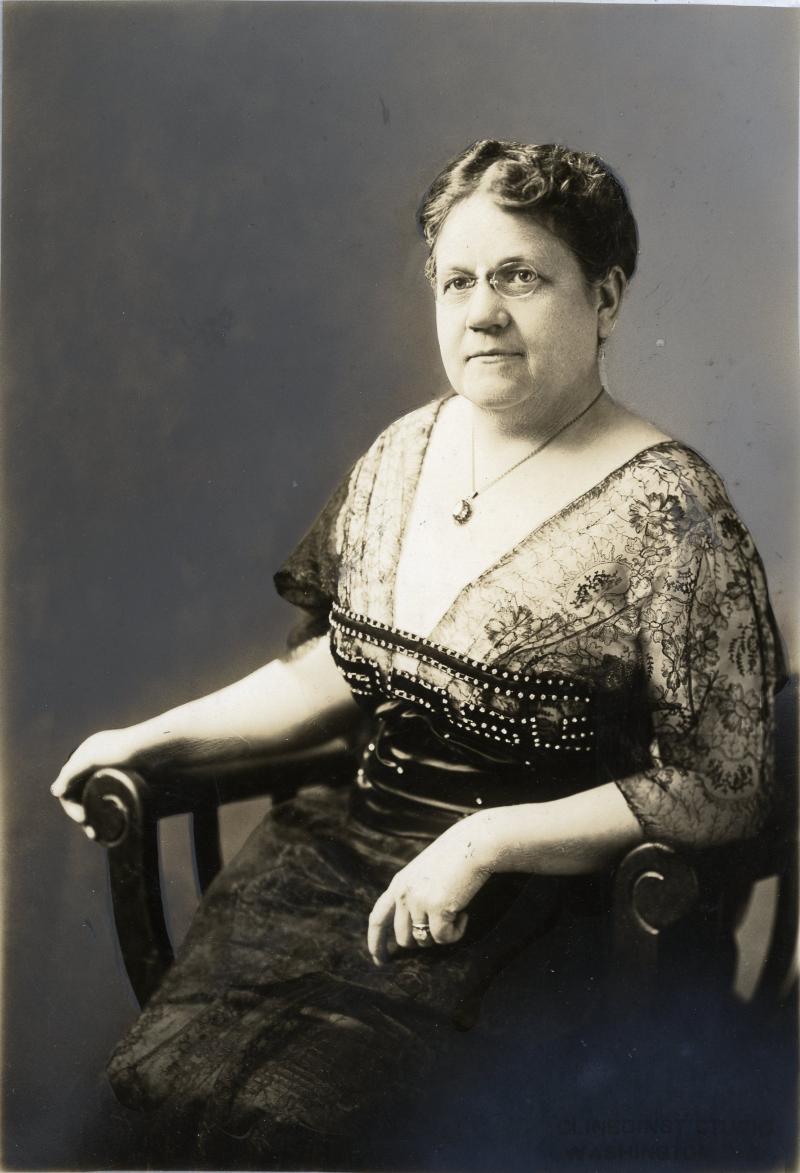
DAR Raises Funds
The Daughters contributed to a “DAR Liberty Loan” with the aim of raising $100,000. The goal was for each DAR member to contribute $1 to the National Society for an endowment fund that would be invested in more bonds.
On display: Letter from President General Sarah Guernsey to DAR Chapter Regents regarding Liberty Loan Fund contributions, September 12, 1918. (NSDAR Archives)
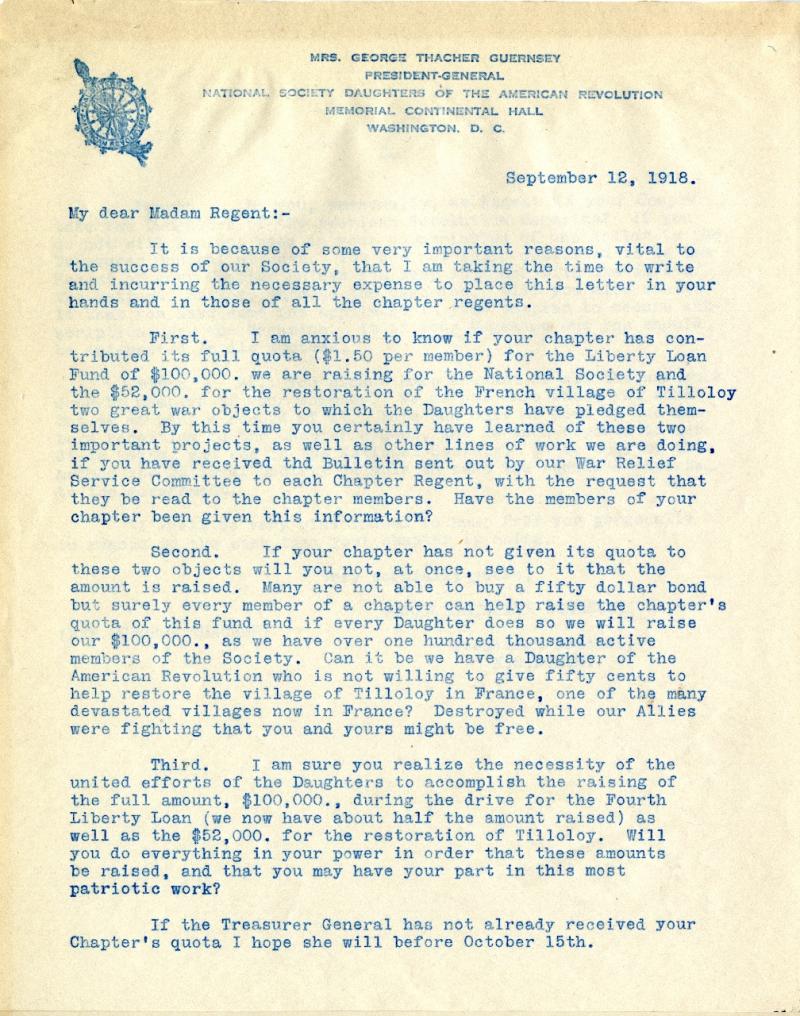
DAR Raises Funds
The First World War cost the federal government more than $30 billion. The Liberty Loan drives became a vital way to raise funds and avoid levying high taxes. The government raised approximately $17 billion through the selling of Liberty bonds.
Besides buying bonds, the Daughters also assisted in selling bonds to the public, raising a reported $51,951,363.
On display: War Relief Service Committee Bulletin No. 16, Liberty Loan, October 13, 1917. (NSDAR Archives)
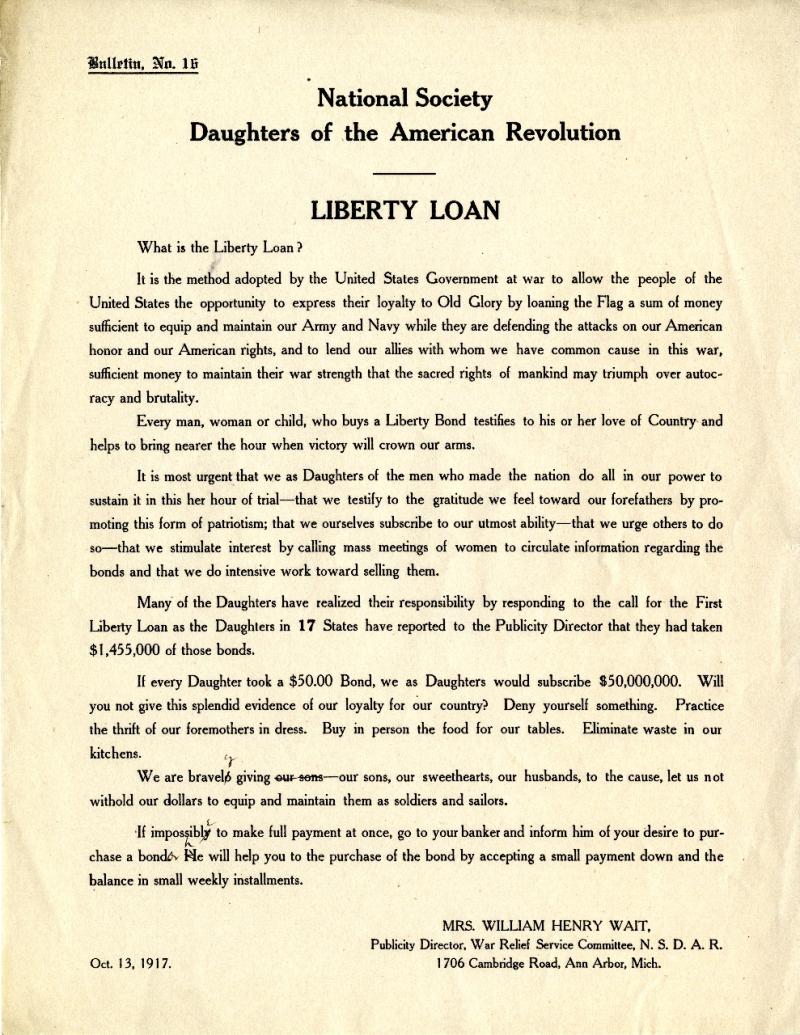
DAR Raises Funds
Patriotic films such as “Eagle’s Wings,” “The Unbeliever,” and “America’s Answer” were presented by DAR Chapters to their communities. Movie nights both encouraged patriotic fervor and provided members with additional funds for their war relief work.
On display: Invitation to the showing of “Eagle’s Wings” at Memorial Continental Hall, from Clara Hadley Wait’s Scrapbook, 1917. (NSDAR Archives)
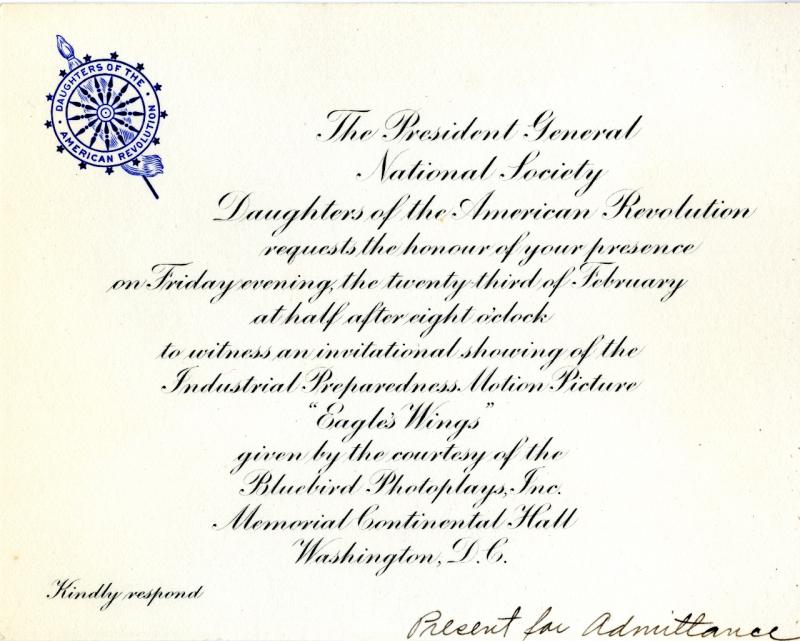
DAR Raises Funds
DAR members registered as public speakers and addressed war rally meetings to raise additional funds and awareness of the needs of soldiers and the importance of purchasing war bonds.
On display: Advertisement for Mrs. Wait’s lecture in Scottville, Michigan, from Clara Hadley Wait’s Scrapbook, circa 1919. (NSDAR Archives)
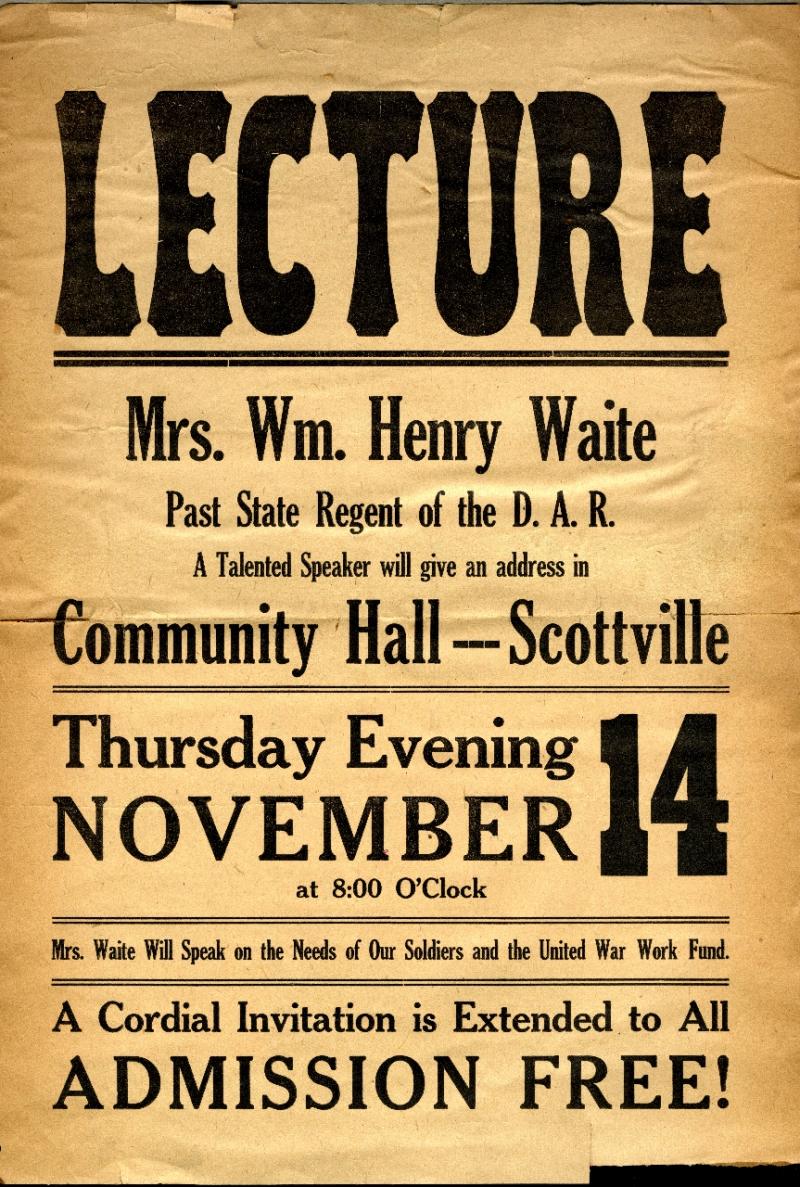
DAR Raises Funds
On display: War Relief Service Committee’s Receipt Book, July 1917-September 1918. (NSDAR Archives)
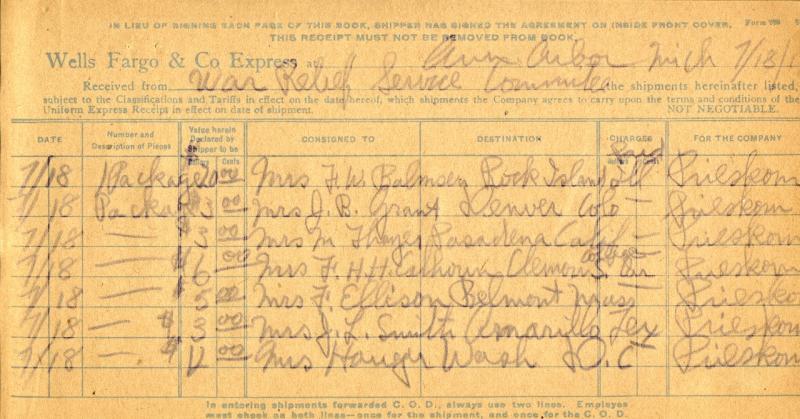
DAR Raises Funds
On display: List of Warren and Prescott Chapter’s (MA) contributions for World War I, June 13, 1917. (NSDAR Archives)
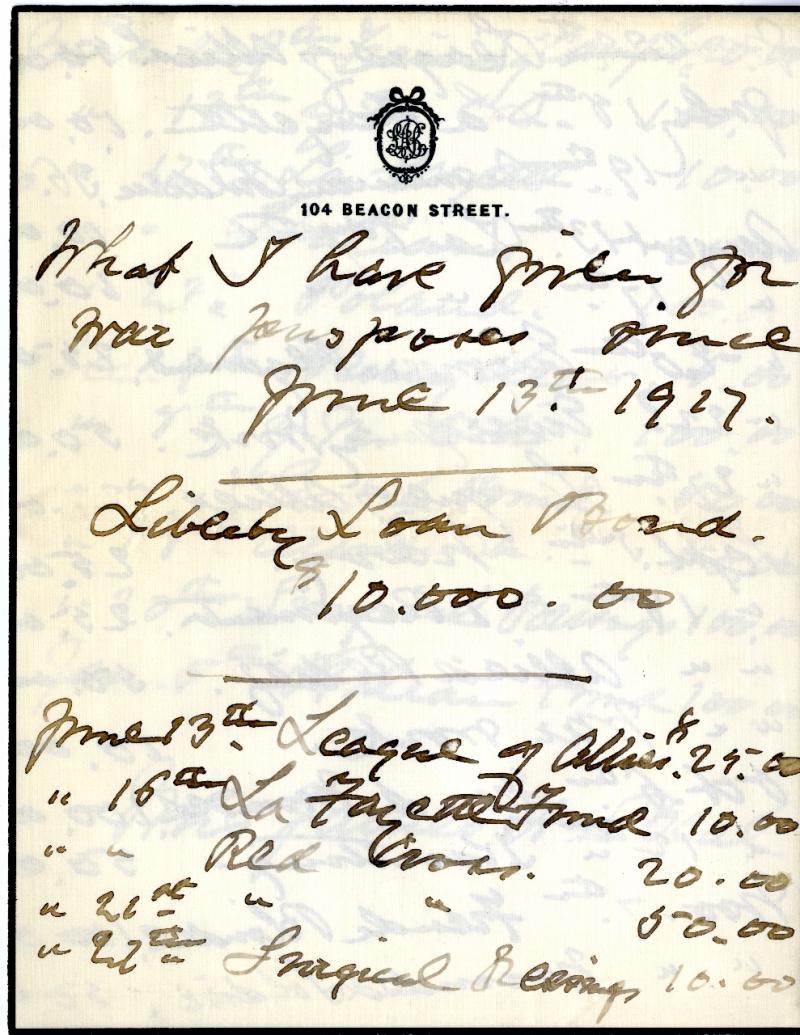
DAR Raises Funds
On display: List of Warren and Prescott Chapter’s (MA) contributions for World War I, June 13, 1917. (NSDAR Archives)
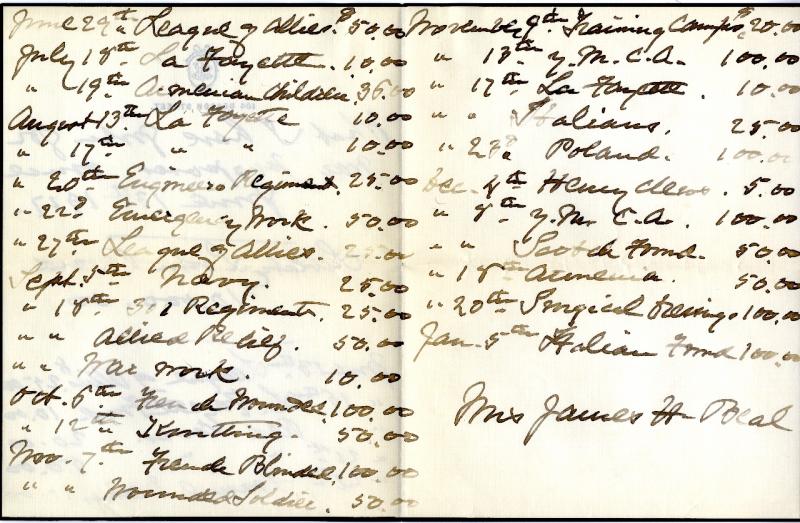
DAR Raises Funds
On display: Excerpt from the June 1917 issue of the DAR Magazine. (NSDAR Archives)
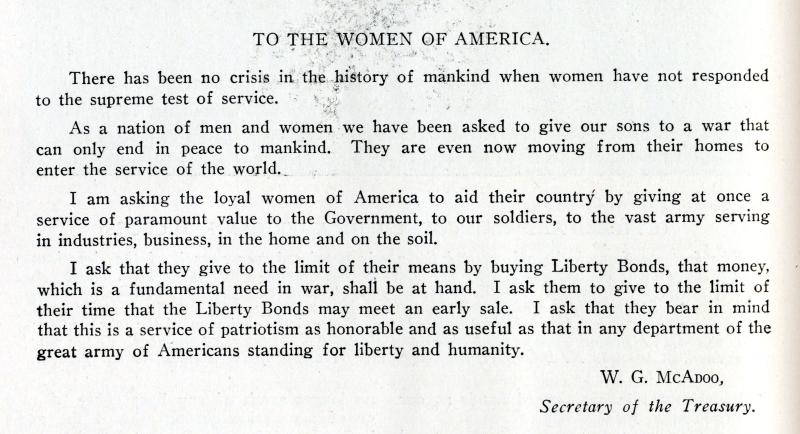
DAR Volunteers from Home
Continuing its patriotic service, the DAR moved beyond fundraising and took on a more prominent role in its communities. The Society’s efforts were recognized by many organizations including the American Red Cross, Navy League of the United States, and YWCA. DAR members formed and led auxiliary chapters for these organizations and collaborated with them in war relief activities.
With the money they raised, DAR members had sufficient resources to fund their diverse war relief projects. One of their most successful ventures was their knitting campaign. Weekly chapter meetings became weekly knitting bees as they made socks, sweaters, hats, and gloves for American soldiers and sailors. Chapters near Army encampments created Camp Hospitality committees to provide much-needed tender loving care to the soldiers. Camp mothers mended clothing, cooked nourishing hot meals, and delivered gifts of books and comfort kits. Chapter members taught classes and gave demonstrations on food conservation practices following the U.S. Food Administration’s guidelines. DAR supported and encouraged its younger members to attend national service schools for military-style training. With these skills, Daughters were equipped to join the workforce as stenographers and telegraph operators for the U.S. government.
DAR Volunteers from Home
This bulletin was one of the most widely circulated by the War Relief Service Committee.
On display: War Relief Service Committee Bulletin No. 12, Home Service, August 29, 1917. (NSDAR Archives)
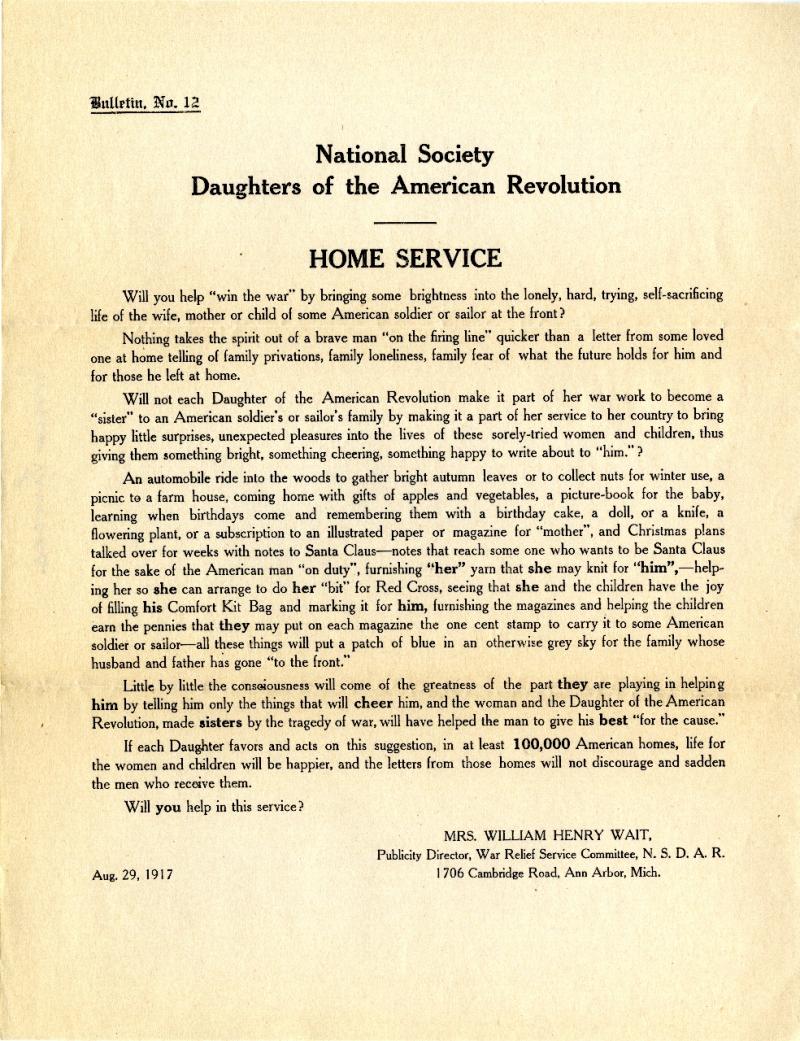
DAR Volunteers from Home
Mrs. Wait introduced a knitting plan that her state of Michigan had approved by the National Board, which was swiftly adopted across the country.
On display: Photograph of Mrs. Wait (right) in her Navy League uniform, from Clara Hadley Wait’s Scrapbook, 1917. (NSDAR Archives)
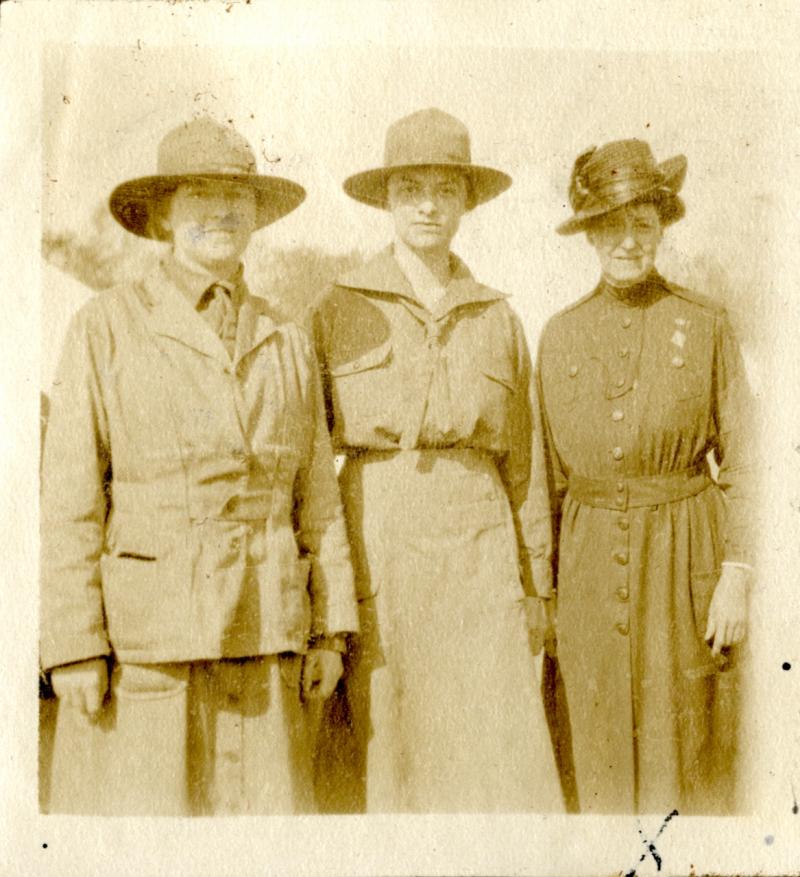
DAR Volunteers from Home
On display: Navy League instructions on knitting sweaters from Warren and Prescott Chapter’s (MA) records, circa 1917-1919. (NSDAR Archives)
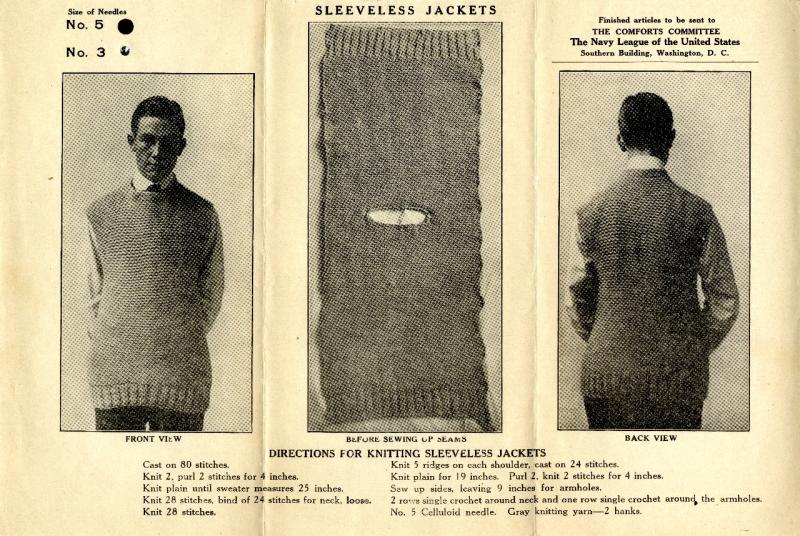
DAR Volunteers from Home
On display: List of knitted items from Warren and Prescott Chapter’s (MA) records, 1918. (NSDAR Archives)
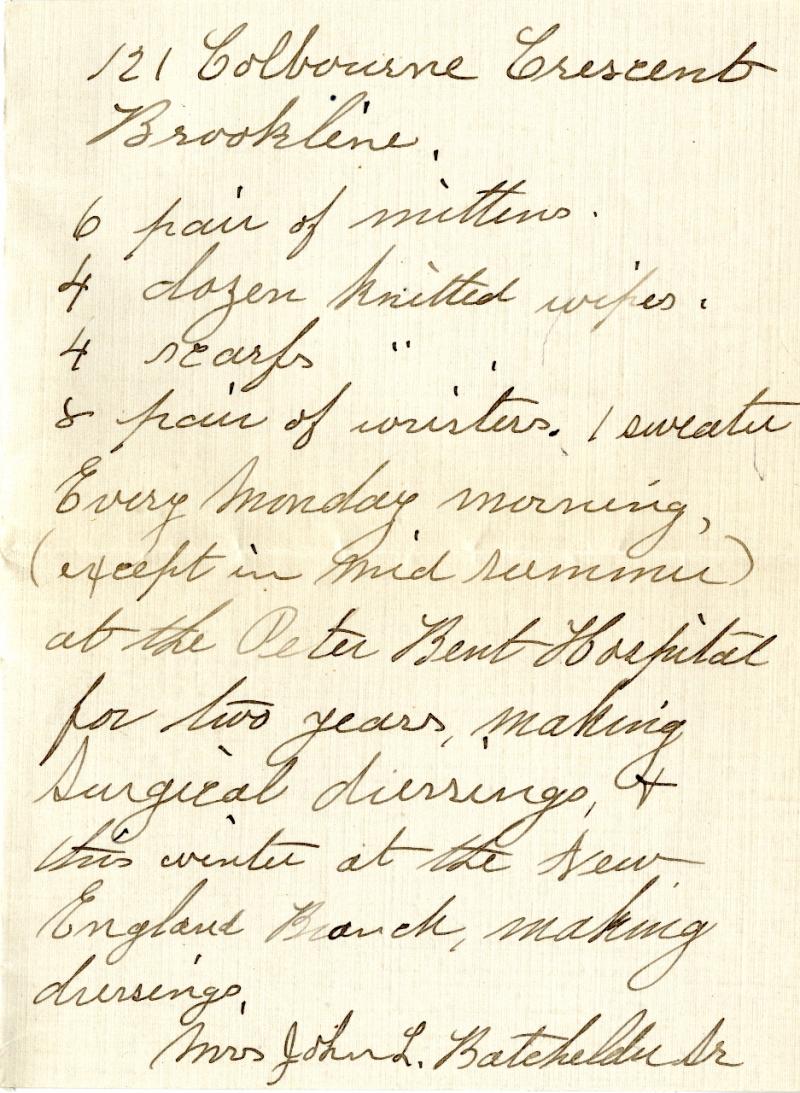
DAR Volunteers from Home
On display: Letter from Officer Clarence S. Schaller at Camp Grayling, Michigan to Mrs. Wait thanking her for knitted items, from Clara Hadley Wait’s Scrapbook, September 6, 1917. (NSDAR Archives)
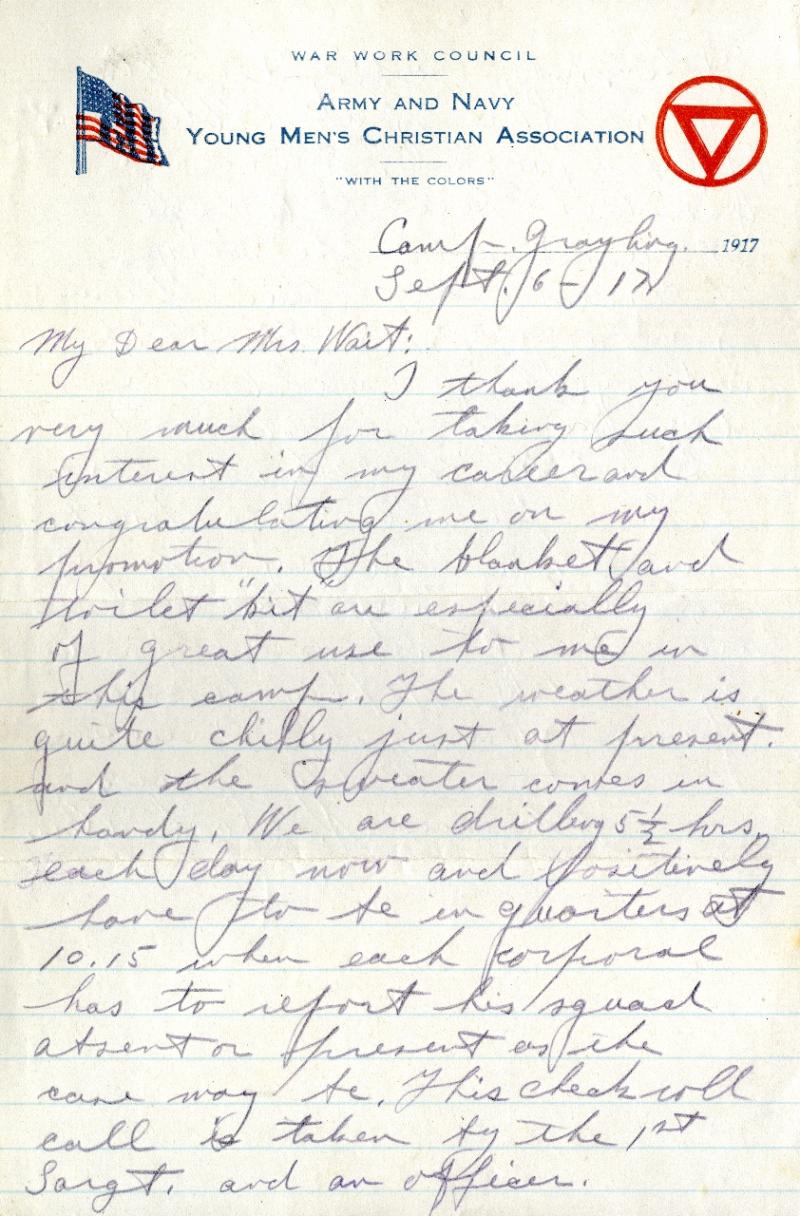
DAR Volunteers from Home
On display: Letter from Officer Clarence S. Schaller at Camp Grayling, Michigan to Mrs. Wait thanking her for knitted items, from Clara Hadley Wait’s Scrapbook, September 6, 1917. (NSDAR Archives)
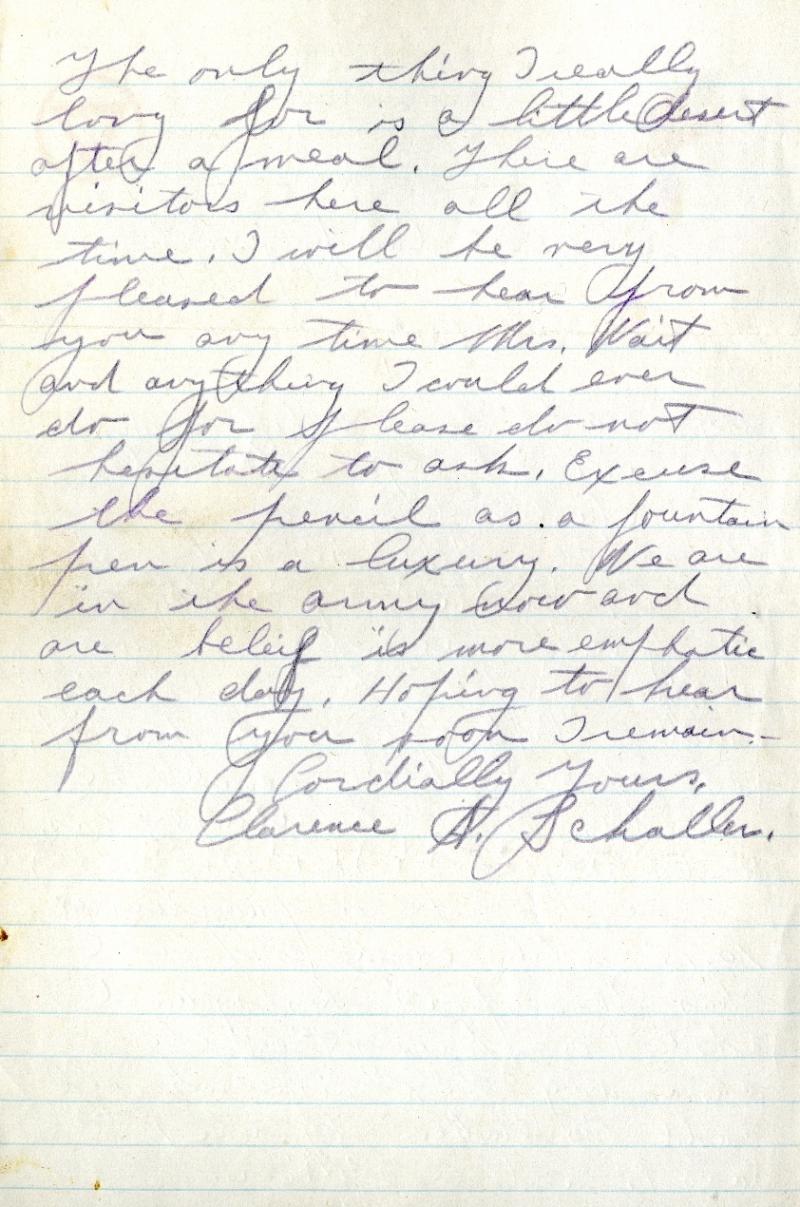
DAR Volunteers from Home
State societies and individual chapters “adopted” battleships, some of which had been named after their state or in honor of Revolutionary War patriots. Chapter members would knit sets of garments and sent them to their State Regent, who packed and sent the garments to the servicemen. Once a package was sent, the chapters would begin again, knitting additional sets of garments for the soldiers and sailors.
On display: Letter from Lieutenant Leo Hewlett Thebaud to Mrs. Wait informing her that the knitted garments had arrived in excellent condition to the U.S.S. Paul Jones and that socks and sweaters are the most used and needed items, from Clara Hadley Wait’s Scrapbook, December 6, 1917. (NSDAR Archives)
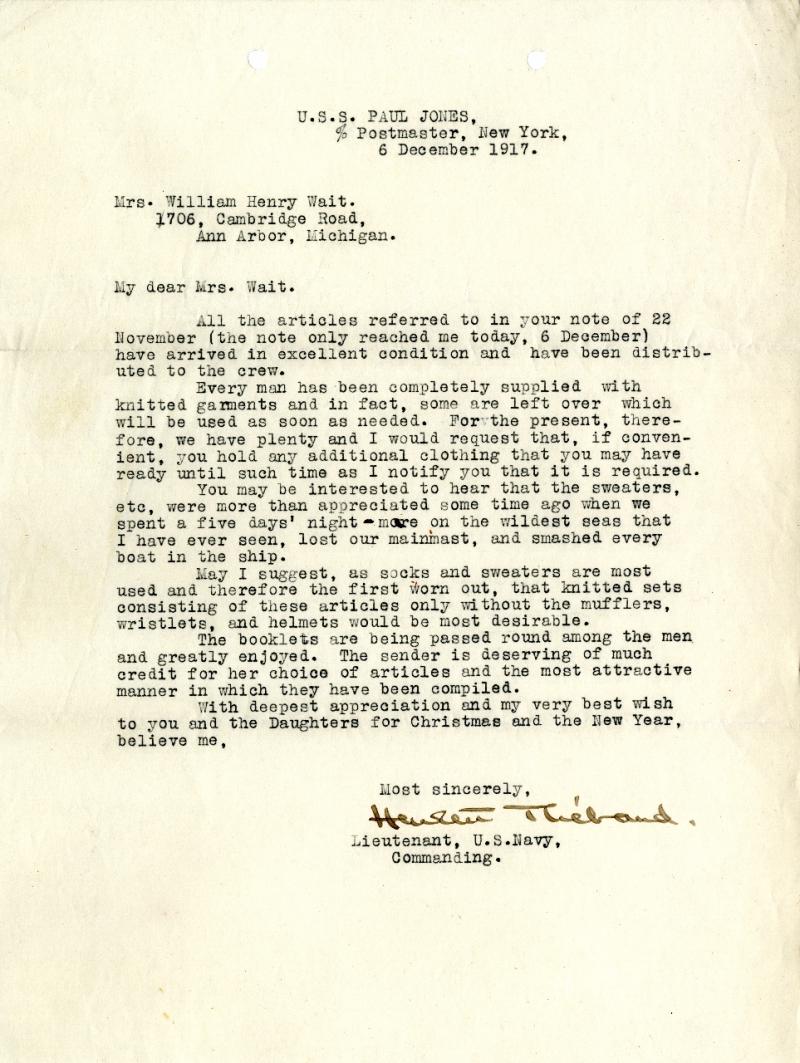
DAR Volunteers from Home
DAR chapters’ knitting circles were so efficient that local Red Cross chapters asked the Daughters to take complete charge of their Knitting Department. The Daughters staffed their local Red Cross rooms, instructing beginners and ensuring an abundance of available yarn.
On display: Photograph of the Louisa St. Clair Chapter knitting on behalf of the Red Cross, from Clara Hadley Wait’s Scrapbook, circa 1917. (NSDAR Archives)
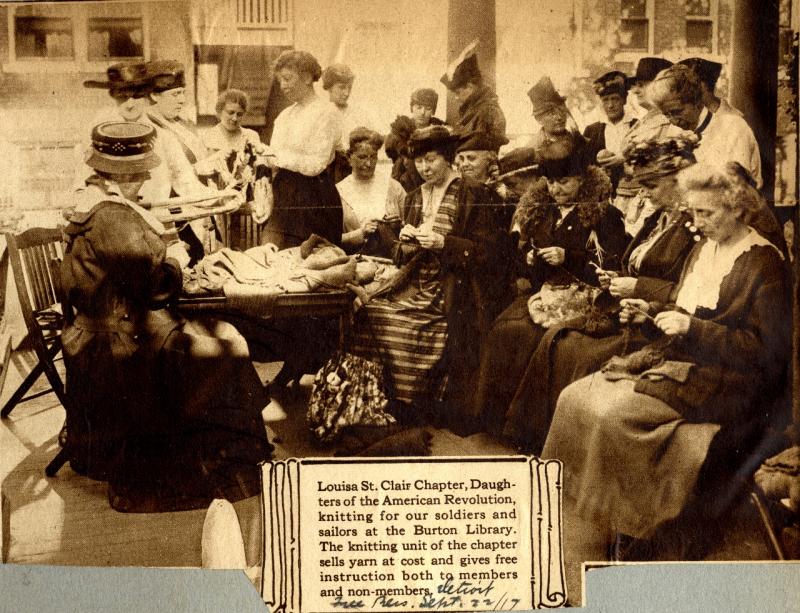
DAR Volunteers from Home
On display: Photograph of Mending Day at Camp Custer, located near Battle Creek, Michigan, 1919. (NSDAR Archives)
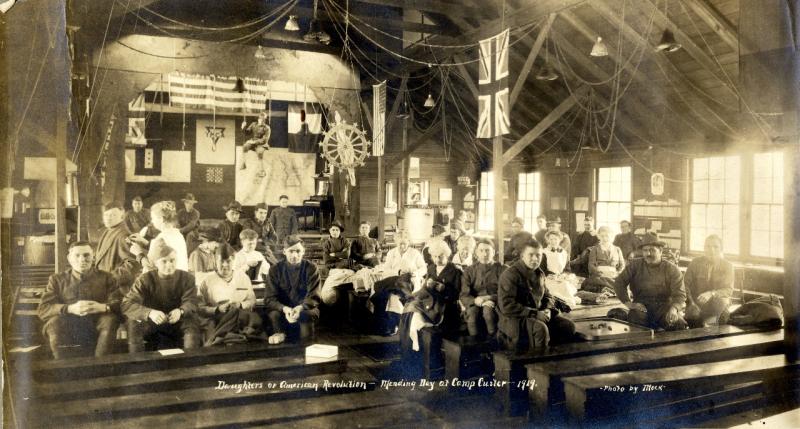
DAR Volunteers from Home
DAR chapters assembled comfort kit bags for soldiers, which could include sewing kits for mending, pocket combs, toothbrushes with toothpaste, small mirrors, handkerchiefs, pencils and pens with writing paper and stamped envelopes/postcards, collapsible aluminum drinking cups, pocket knives, leather shoe laces, black shoe polish, and items for shaving.
On display: Women’s Section Navy League instructions on creating comfort kits from Warren and Prescott Chapter’s (MA) records, circa 1917-1919. (NSDAR Archives)
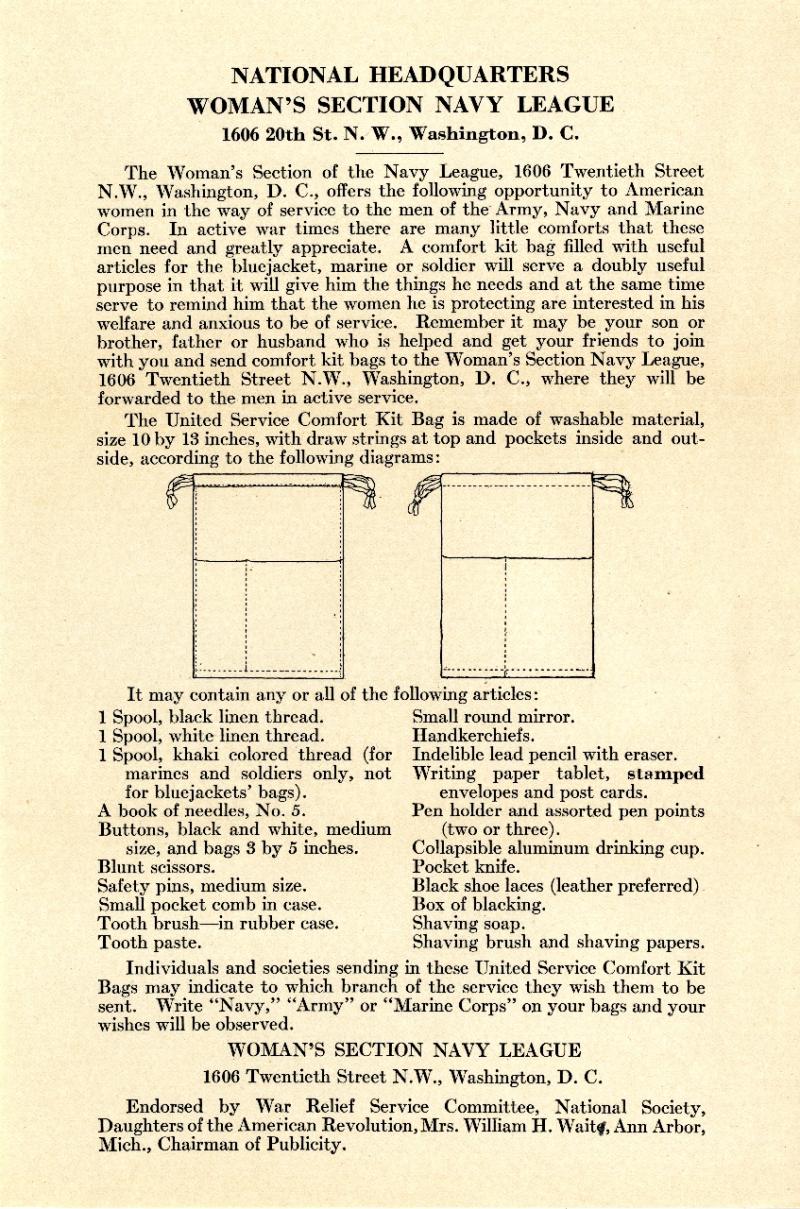
DAR Volunteers from Home
At the invitation of Major General Edwin F. Glenn, commander at Camp Sherman located near Chillicothe, Ohio, and backed by the Secretary of War, Newton D. Baker, the Ohio Daughters built a “DAR Lodge,” dedicating it on December 19, 1917. The Ohio Daughters were commissioned by the government to build and maintain a hostess house at a cantonment for the comfort of women visiting the camp. It cost the Ohio DAR members $21,847.78. The Lodge provided 65 sleeping rooms, which had electricity and were heated. They were furnished with a small iron bed, dresser, washstand and chairs. Four large living rooms with open fireplaces and wide porches offered space for meeting their loved ones. A Daughter served as hostess at the Lodge, keeping the doors open day and night throughout the war.
On display: Photograph shows the dedication of Daughters at the DAR Lodge at Camp Sherman, Chillicothe, Ohio, December 17, 1917. (NSDAR Archives)
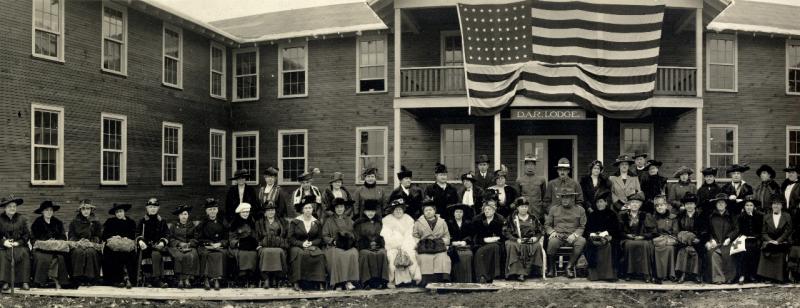
DAR Volunteers from Home
All gifts of knitted garments, clippings, comfort kit bags, etc. to soldiers were plainly marked with a card bearing the DAR insignia.
On display: Card noting the name, address, and regent of a DAR chapter and the type of jelly that was canned, from Clara Hadley Wait’s Scrapbook, November 23, 1917. (NSDAR Archives)
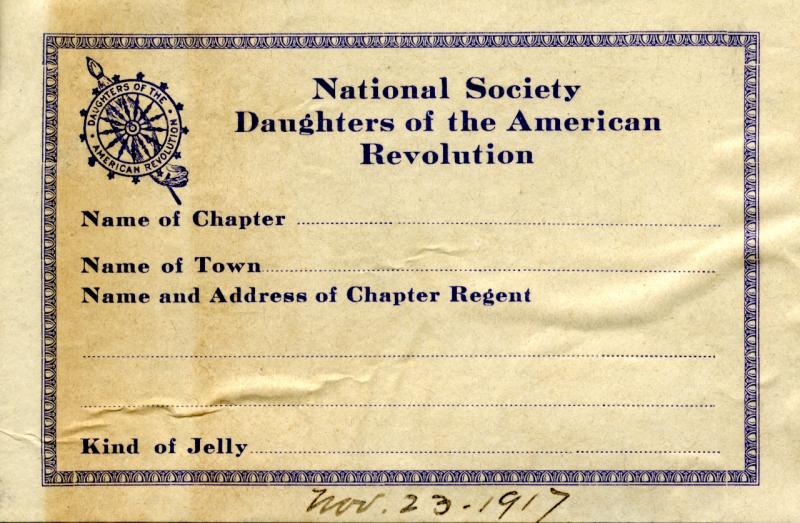
DAR Volunteers from Home
One of the best ways the DAR contributed to the war relief effort was through its support of the U.S. Food Administration which was led by a young Herbert Hoover. Hoover strove to appeal to American patriotism, to encourage Americans to voluntarily make sacrifices to increase food production, and to decrease food consumption. Hoover wrote to the National Society asking for their cooperation in conservation programs. DAR members responded and pledged their participation. Besides giving up refreshments at their chapter meetings, the Daughters also embraced wheatless and meatless days of the week.
Victory gardens were planted and the excess produce was made into jams and jellies for the soldiers. DAR members taught classes in their communities and gave demonstrations regarding the best methods of canning, how to substitute wheat in their cooking, and other recipes and conservation topics.
On display: War Relief Service Committee Bulletin No. 7, Food, July 9, 1917. (NSDAR Archives)
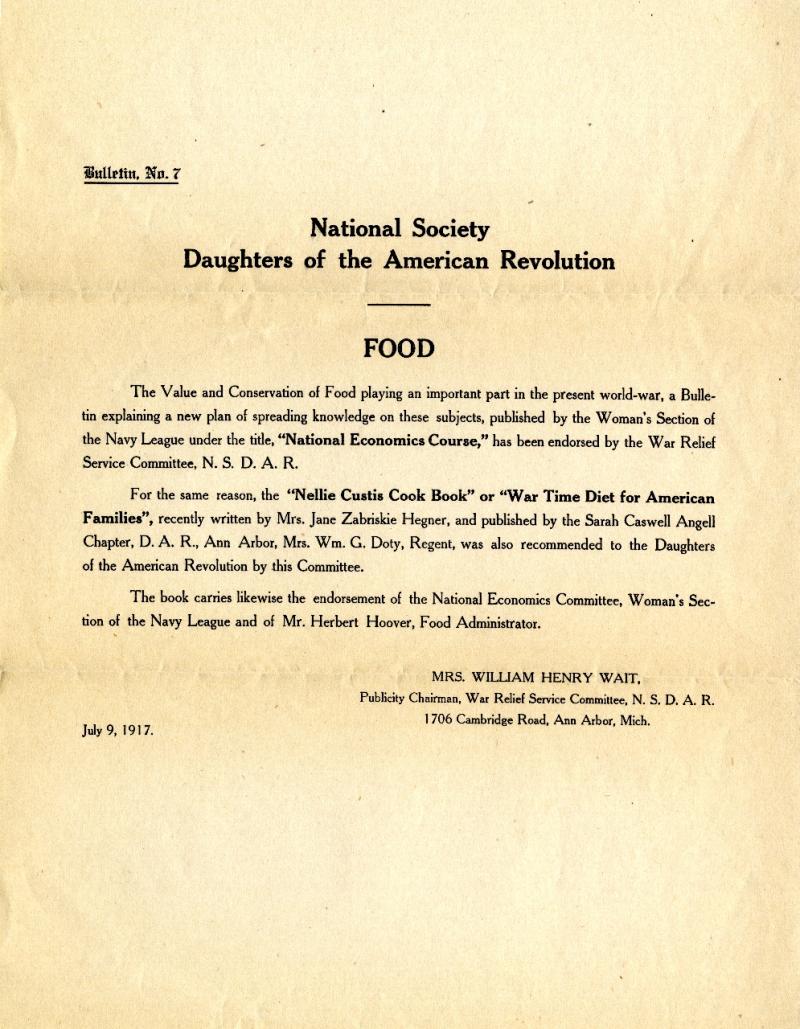
DAR Helps Overseas
DAR sent support overseas even before the U.S. entered the war. Belgium’s and France’s food supplies were diminished and famine was threatening both countries. The war had decimated villages in France leaving a half million children fatherless. The French government struggled with the financial burden and was seeking support from its allies.
DAR joined the American Commission for Relief in Belgium which raised money throughout the world, purchased food, and arranged to ship it to Belgium. Chapter members sewed clothing and contributed to the Belgian Baby Milk Fund. The Daughters responded to France’s needs by “adopting” or sponsoring children through the Fatherless Children of France organization. The War Relief Service Committee also supported the American Committee for Devastated France’s plan to “rechickenize” France. The village of Tilloloy was devastated in the war. The DAR pledged to rebuild the village as repayment to France for its aid during the American Revolution.
DAR Helps Overseas
In 1917 this medal was presented to NSDAR by the American Commission for Relief in Belgium, in gratitude for DAR’s service. President General Story urged DAR members to raise money for Belgium relief even before the U.S entered the war. The DAR raised more than $148,615.99 by June 1916.
On display: Bronze medal presented to NSDAR from the American Commission for Relief in Belgium. The obverse depicts the heads of the King and Queen of Belgium and the reverse features an allegorical image of Liberty comforting the poor. Tiffany and Co., 1916. (Courtesy of DAR Museum, acc. 362)
DAR Helps Overseas
In 1917 this medal was presented to NSDAR by the American Commission for Relief in Belgium, in gratitude for DAR’s service. President General Story urged DAR members to raise money for Belgium relief even before the U.S entered the war. The DAR raised more than $148,615.99 by June 1916.
On display: Bronze medal presented to NSDAR from the American Commission for Relief in Belgium. The obverse depicts the heads of the King and Queen of Belgium and the reverse features an allegorical image of Liberty comforting the poor. Tiffany and Co., 1916. (Courtesy of DAR Museum, acc. 362)
DAR Helps Overseas
On display: Photograph of Belgian Relief workers at a drive for old clothing, Mercy Warren Chapter (MA), July, 1918. (NSDAR Archives)
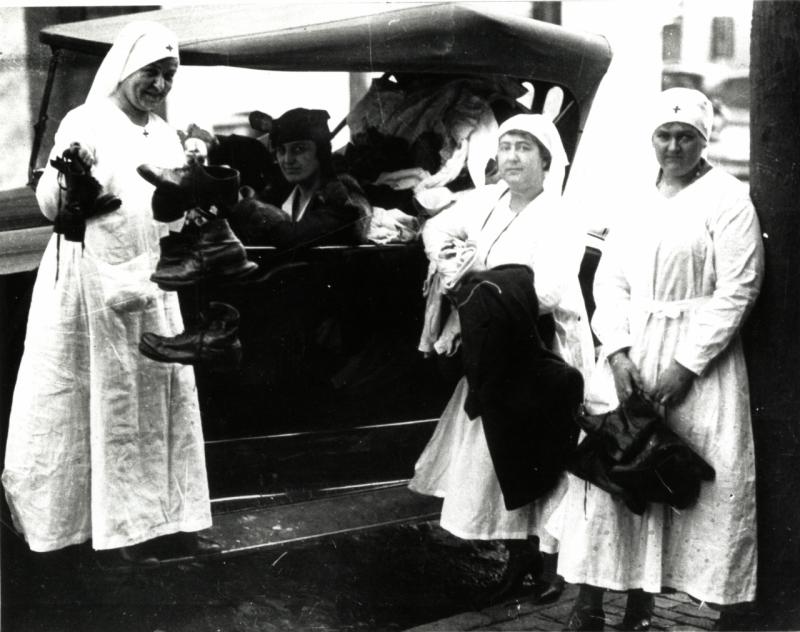
DAR Helps Overseas
At the 26th Continental Congress, President General Story read this letter from former President Theodore Roosevelt in which he rallied the Daughters to assist France. Roosevelt reported that half a million French children had lost their fathers in the war and that the French government, “staggering under the stupendous financial burdens of the war,” could not fully support the orphaned children.
On display: Letter from President Theodore Roosevelt to President General Daisy Story regarding helping with French orphans, April 17, 1917. (NSDAR Archives)
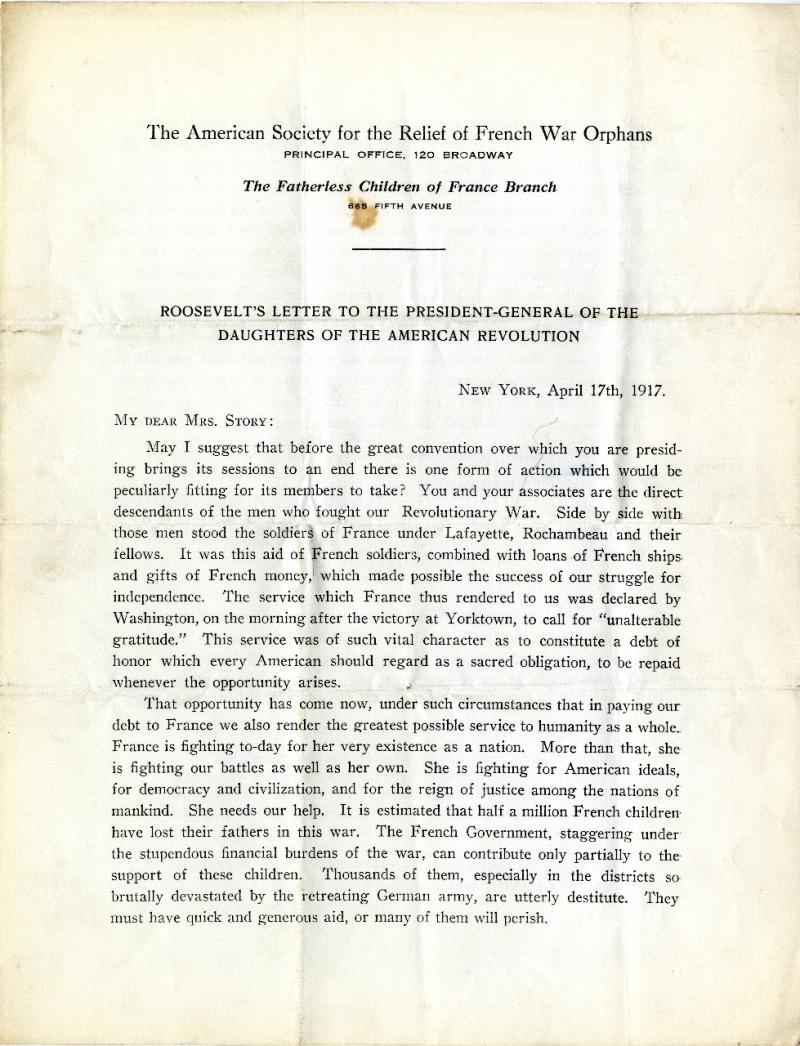
DAR Helps Overseas
At the 26th Continental Congress, President General Story read this letter from former President Theodore Roosevelt in which he rallied the Daughters to assist France. Roosevelt reported that half a million French children had lost their fathers in the war and that the French government, “staggering under the stupendous financial burdens of the war,” could not fully support the orphaned children.
On display: Letter from President Theodore Roosevelt to President General Daisy Story regarding helping with French orphans, April 17, 1917. (NSDAR Archives)
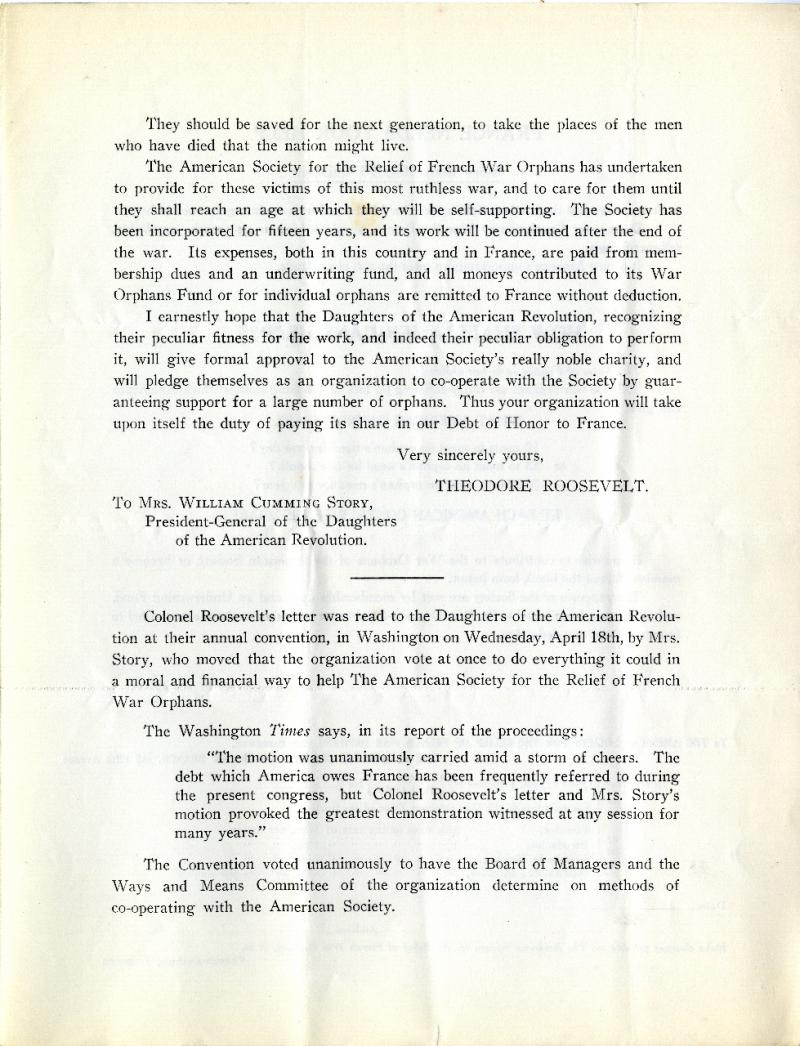
DAR Helps Overseas
The Daughters answered the call and began “adopting,” or sponsoring, the children. $36.50 supported one child for one year. The DAR sent donations to the Fatherless Children of France organization, which in turn sent quarterly payments to the children’s guardians. DAR members, both individually and with their chapters and state societies, supported the orphans, often “adopting” entire families. By the end of the war, more than 4,000 children were sponsored by the DAR.
On display: Advertisement, France Needs Your Help, 1916-1917. (NSDAR Archives)
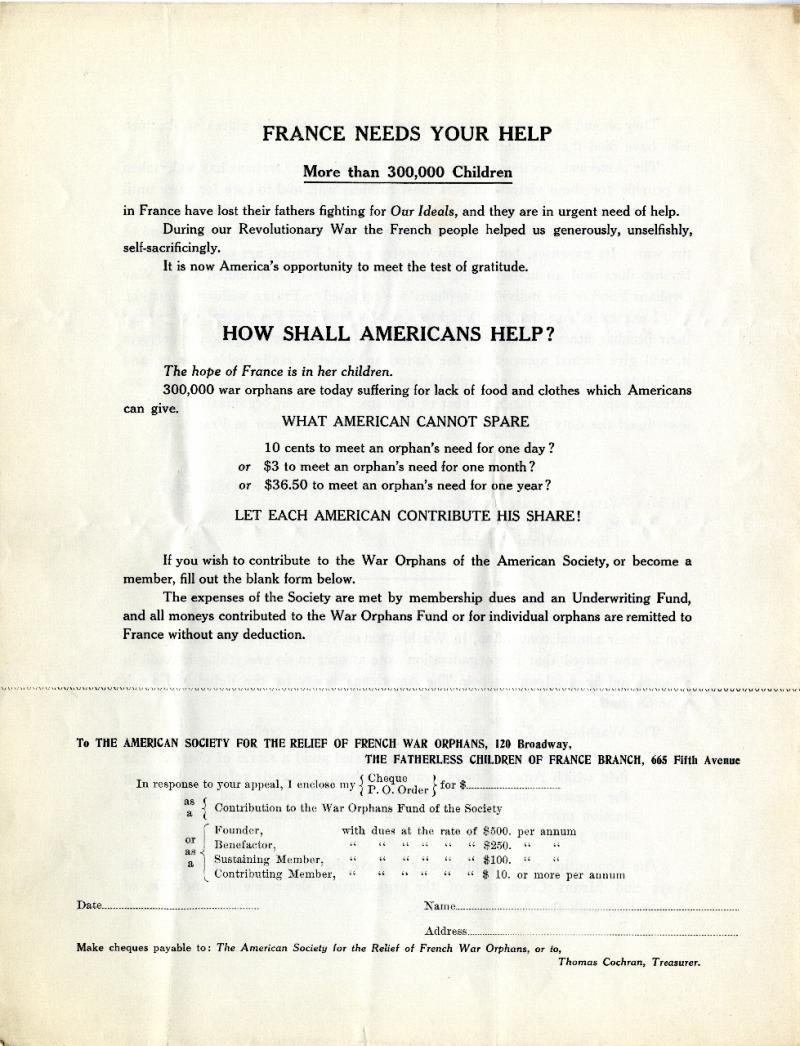
DAR Helps Overseas
On display: Scrapbook from Canoe Place Chapter (PA). Left page shows a photograph of French orphan sponsored by the chapter and right page shows a record of their war time activities, 1917-1920. (NSDAR Archives)
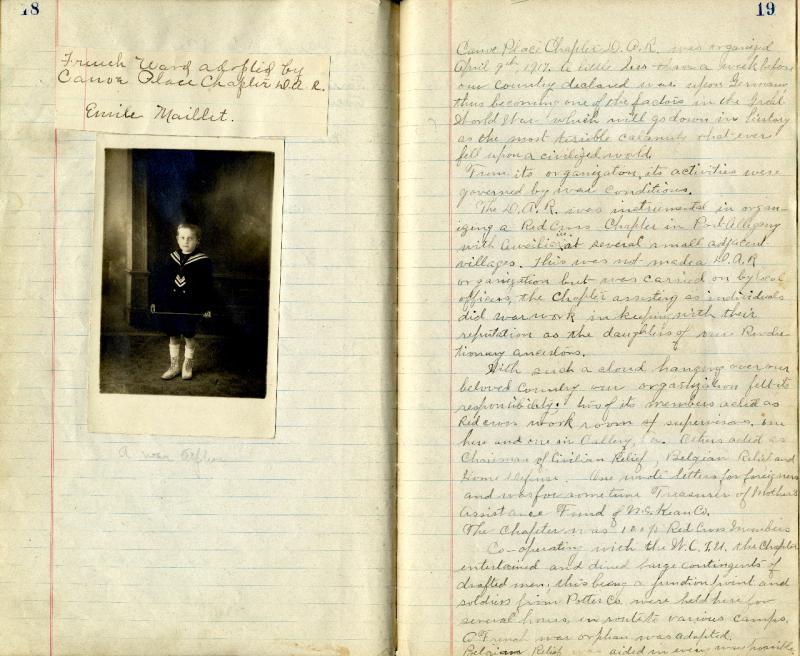
DAR Helps Overseas
On display: Photograph of two French orphans sponsored by the Faneuil Hall Chapter (MA), circa 1917-1920. (NSDAR Archives)

DAR Helps Overseas
On display: Translated letter from Madame Lemaringer, mother of a French orphan, to Annie P. Hutchinson, Chapter Regent of Faneuil Hall Chapter (MA), May 1918. (NSDAR Archives)
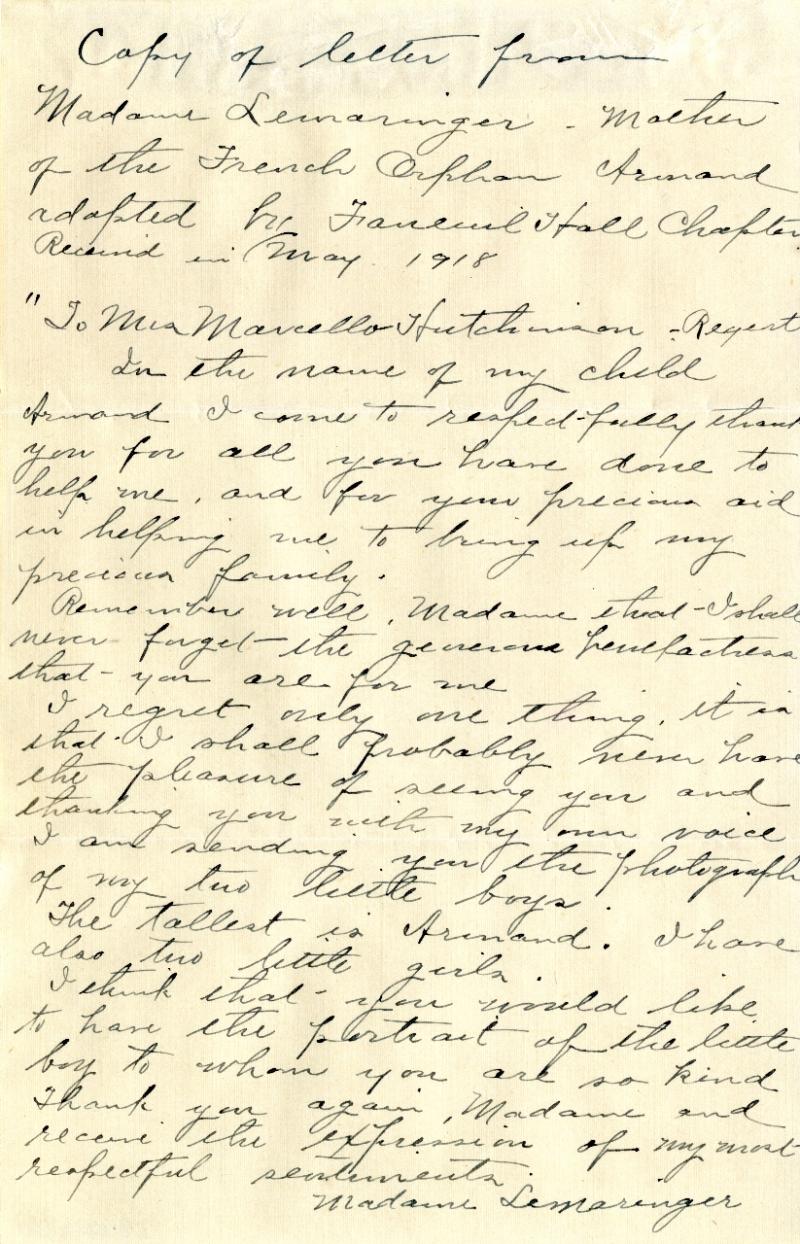
DAR Helps Overseas
Marie Wilkinson Hodgkins
Secretary of the War Relief Service Committee
Throughout the war, Mrs. Hodgkins, Secretary of the War Relief Service Committee, was in charge of coordinating the work for the French orphans. She devoted herself entirely to the project until the end of the war, working 8-hour days to place the financial care of thousands of orphans in the hands of the chapters from throughout the country. She facilitated the adoption of more than 4,000 French war orphans.
In a letter thanking the “Fairy Godmothers of France’s future citizens,” the French ambassador’s wife, Elise Jusserand, stated:
I wish the Daughters of the American Revolution who have “adopted” our little ones could realize, as I do, who am just back from France, all that their help and sympathy mean to them. It means sometimes the proper food necessary for a child's health, sometimes the pair of shoes which can enable the child to go to school, and at all times it means carrying the word “America” into thousands of French homes where it will remain a symbol of fraternity, ever respected and beloved.
On display: Photograph of Marie Wilkinson Hodgkins, circa 1908. (NSDAR Archives)
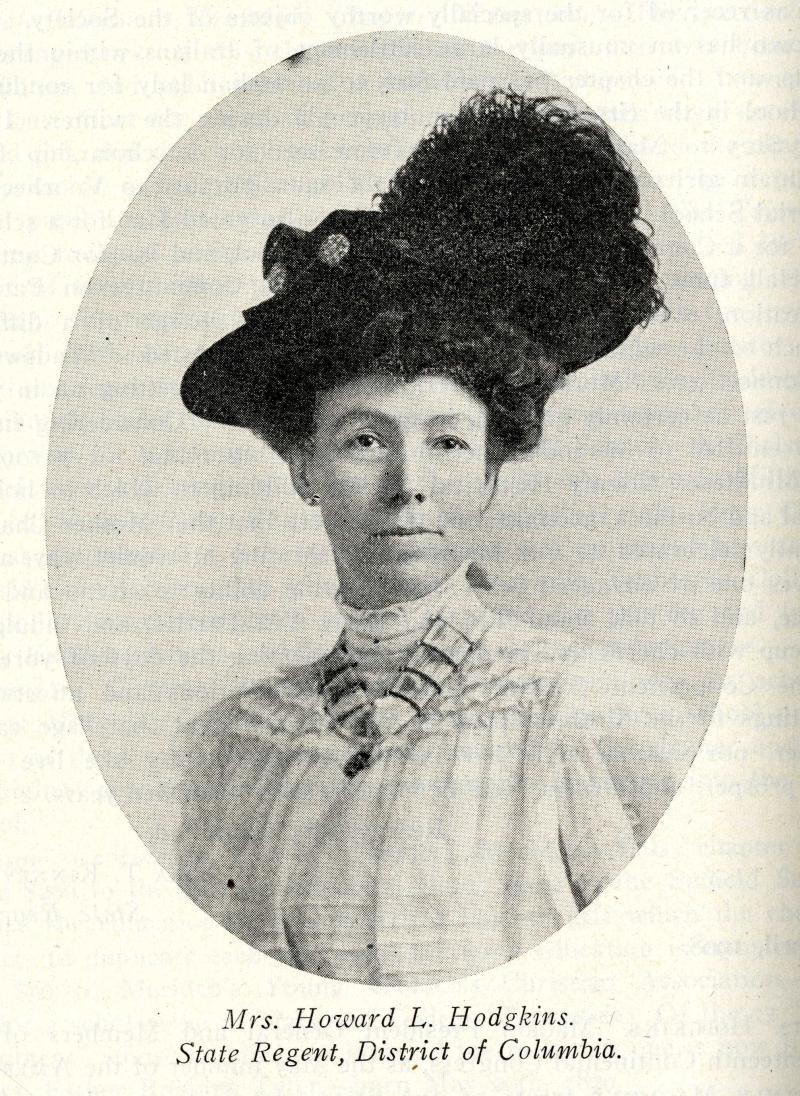
DAR Helps Overseas
By June 1918, the War Relief Service Committee learned of the American Committee for Devastated France’s plan to “rechickenize” France. The DAR responded with a bulletin proposing that Daughters organize local campaigns to involve their communities’ children in the war relief effort. The goal of the fundraising campaign was to supply the French people with much-needed poultry farms to fill a gap in their food supply. Ten cents placed an egg in an incubator. Twenty-five cents placed a chick on a farm. Four hundred dollars established a poultry farm with two incubators, 1,000 eggs, and one wounded soldier to work as the “poultry man” for one year.
On display: Letter from Lucy Hewitt to Mrs. Wait regarding the rechickenization project and thanking her for her donation with a chicken button, from Clara Hadley Wait’s Scrapbook, July 7, 1918. (NSDAR Archives)
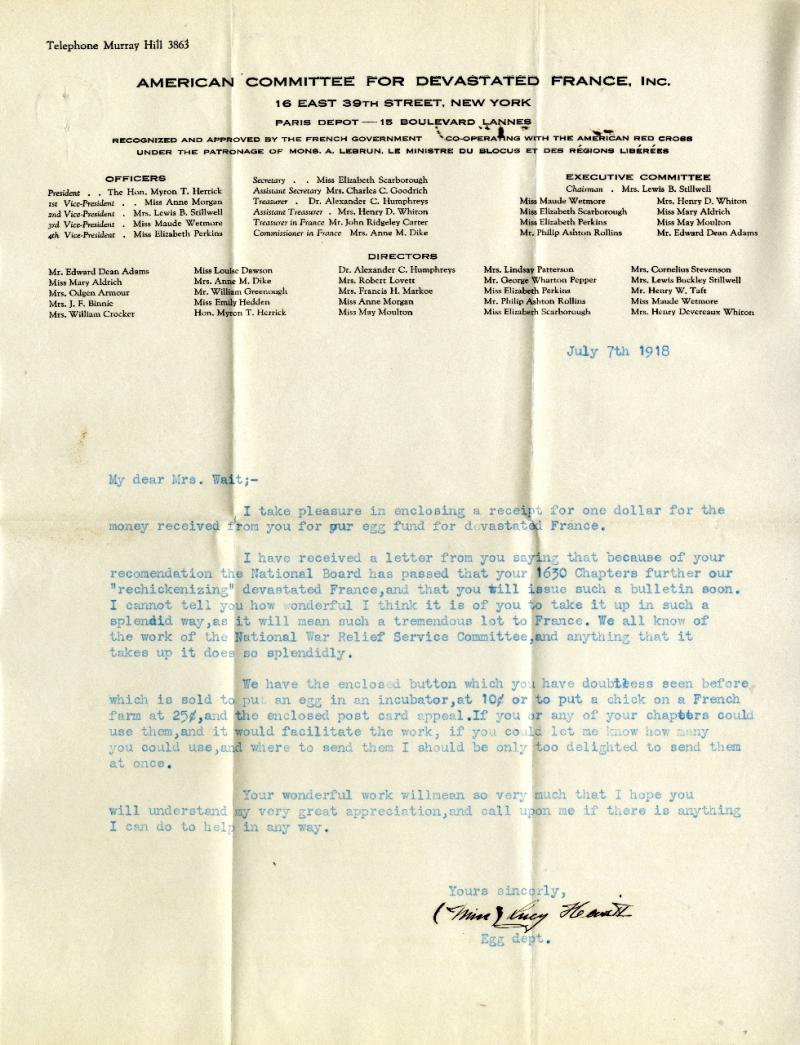
DAR Helps Overseas
To encourage donations, the DAR created an “I have a chicken in France” button pin, given for the 10 or 25 cent donations.
On display: Small navy blue pin with a red chicken, reads, “I have a Chicken in France,” circa 1918. (NSDAR Archives)
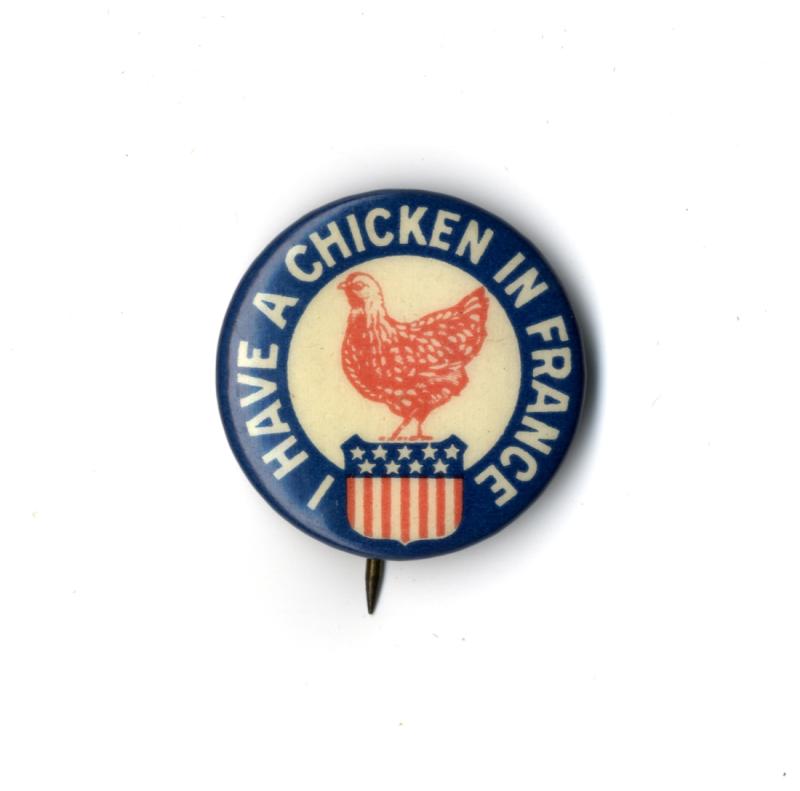
DAR Helps Overseas
On display: War Relief Service Committee Bulletin No. 35, Re-Chickenize France, July 24, 1918. (NSDAR Archives)
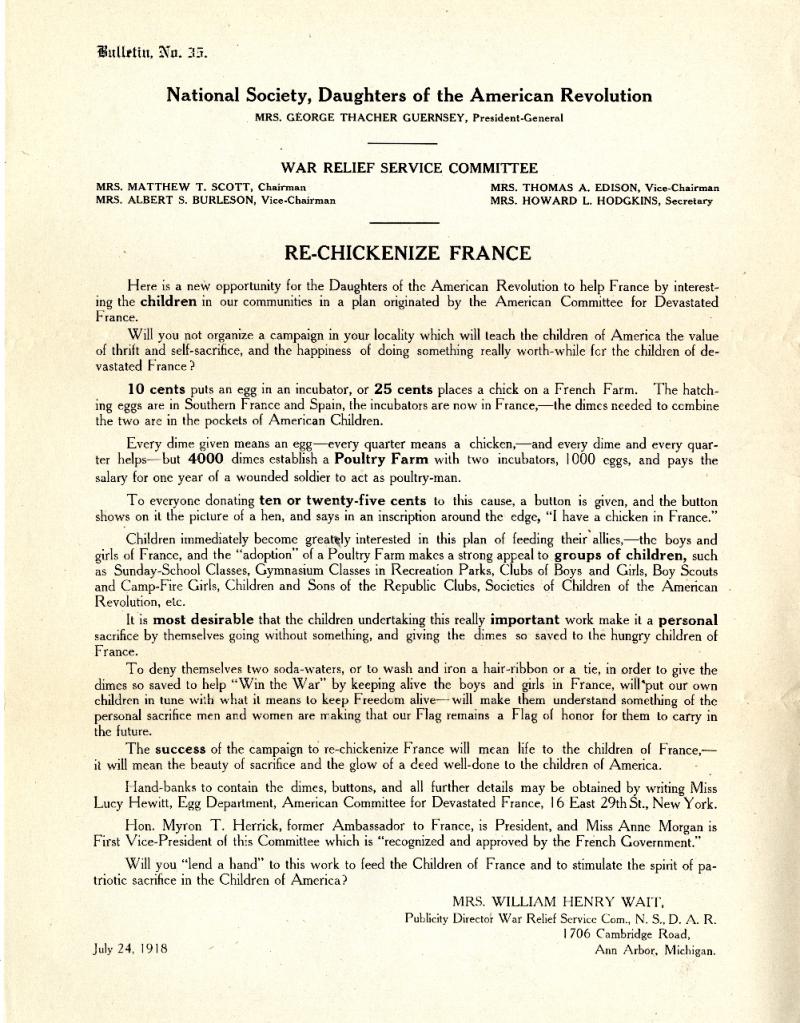
DAR Helps Overseas
During summer 1917, Miss Terèse d’Hinnisdal, the daughter of the mayor of Tilloloy, a small French village in northern France, reported on the destruction visited on her once-beautiful hometown. Elise Jusserand, the wife of the French ambassador, contacted Mrs. Scott, introducing the DAR to one of its largest and proudest achievements in war relief service.
On display: Postcards of Château de Tilloloy, home of the d’Hinnisdal family, before and after bombardment, 1914 and circa 1917. (NSDAR Archives)
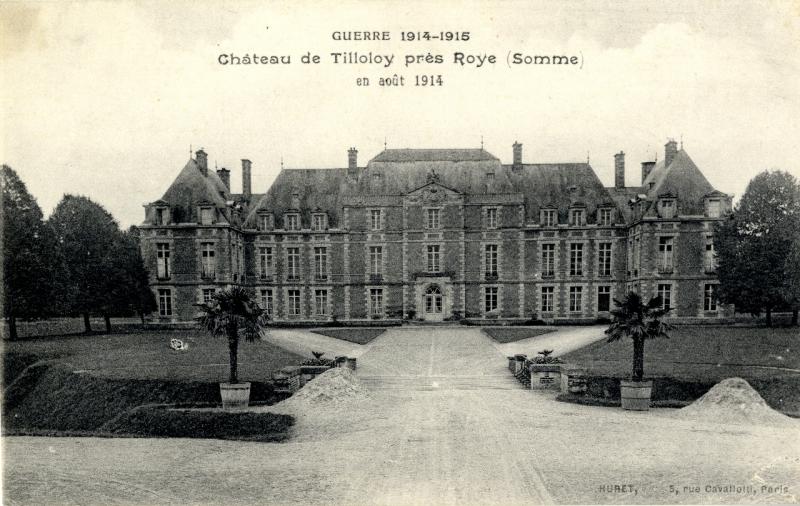
DAR Helps Overseas
During summer 1917, Miss Terèse d’Hinnisdal, the daughter of the mayor of Tilloloy, a small French village in northern France, reported on the destruction visited on her once-beautiful hometown. Elise Jusserand, the wife of the French ambassador, contacted Mrs. Scott, introducing the DAR to one of its largest and proudest achievements in war relief service.
On display: Postcards of Château de Tilloloy, home of the d’Hinnisdal family, before and after bombardment, 1914 and circa 1917. (NSDAR Archives)
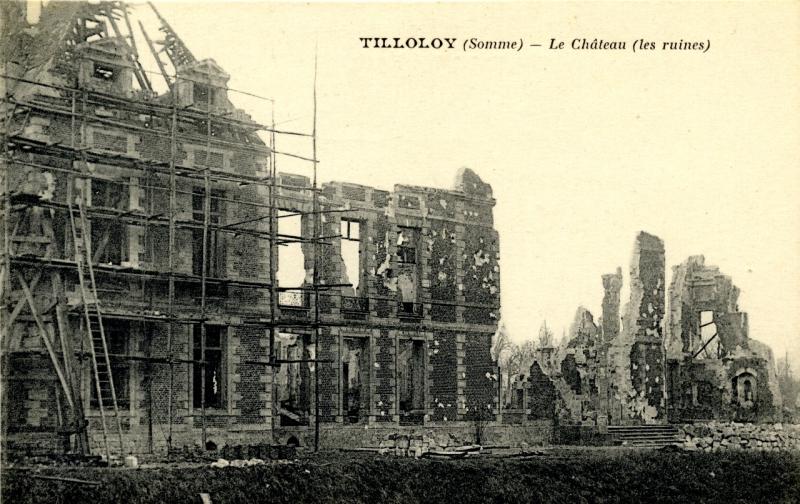
DAR Helps Overseas
For the reconstruction of Tilloloy, President General Guernsey appealed to the state societies and chapters suggesting that each member contribute 50 cents. The DAR’s original plan was to raise the necessary funds to build sixty houses, complete with furnishings, farm tools, and livestock. During summer 1919, Mrs. Guernsey and her sister, Mrs. Aull, Vice President General from Nebraska, traveled to France to consider the most appropriate way to aid Tilloloy. They decided ultimately to fund a complete water system for the village.
On display: Photograph of the future Tilloloy fountain site after bombardment, circa 1914. (NSDAR Archives)
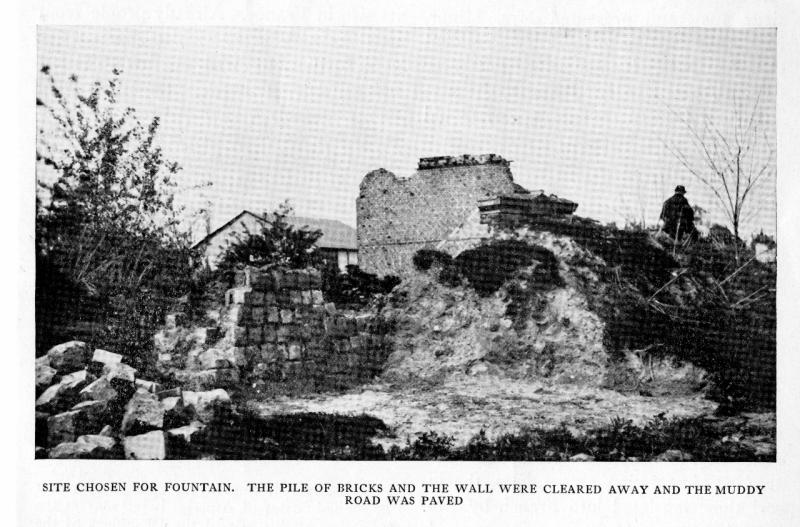
DAR Helps Overseas
A fitting and lasting gift from the Daughters, the water system consisted of an artesian well, a large reservoir, a windmill, ten or twelve small hydrants along the roads, two fire hydrants, and two watering troughs for animals, one of which was also a decorative fountain.
On display: Photograph of the decorative fountain which is part of the water system presented to the village of Tilloloy, 1921. (NSDAR Archives)
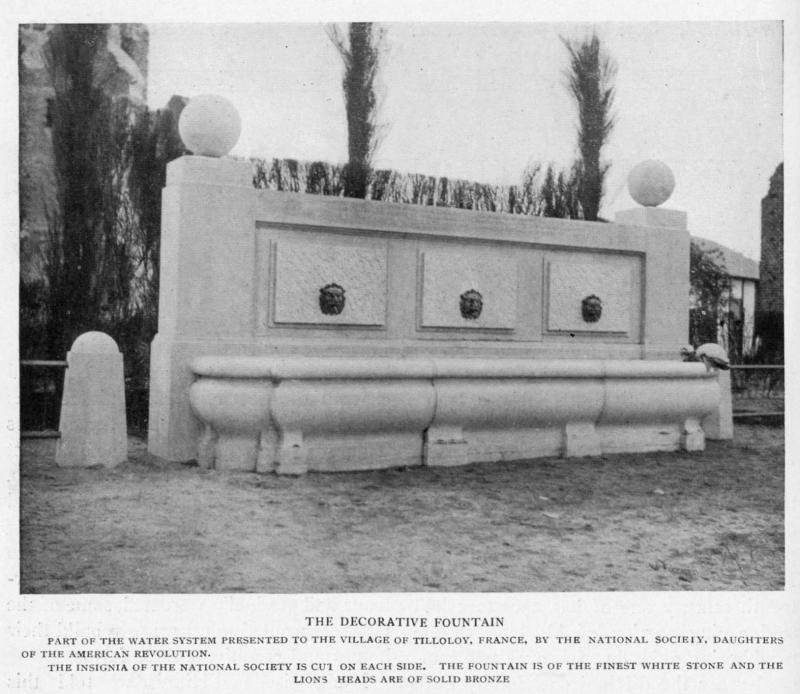
DAR Helps Overseas
A ceremony attended by many DAR members and French nobles was held on August 23, 1921 to celebrate the completion of the water system. President General Minor said in her speech:
In presenting this gift from our Society, I am expressing the love, the honor, the high regard in which France is held by every Daughter of the American Revolution. These waterworks betoken the friendship, the gratitude, the love which our Society bears to France today, and which our ancestors bore to Lafayette and to the France of long ago.
On display: Photograph of President General Anne Minor with the French ambassador to the U.S., Jean Jules Jusserand, and his wife, Elise Richards Jusserand. Tilloloy, August 23, 1921. (NSDAR Archives)
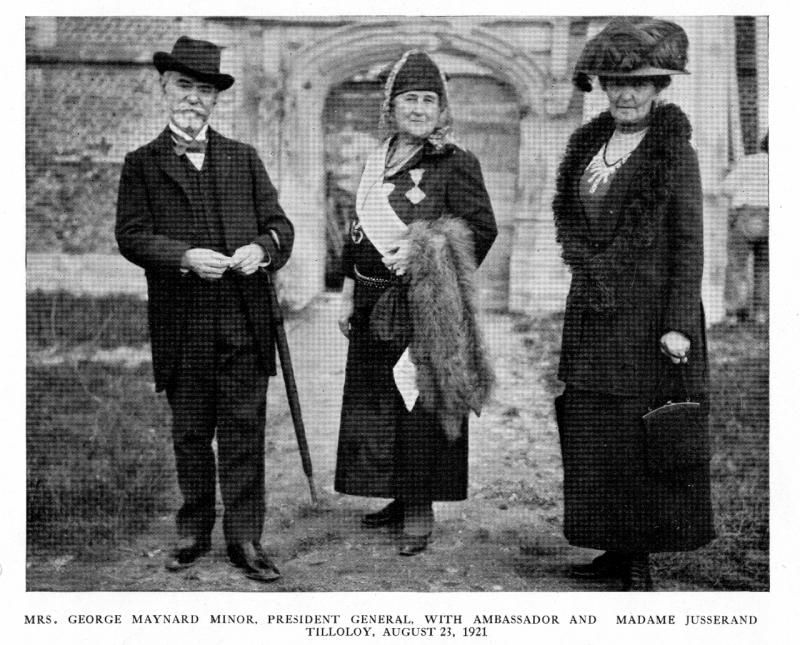
DAR Helps Overseas
Ambassador Jusserand presented the Médaille de la Reconnaissance Française, or the Medal of French Gratitude, to President General Anne Minor, Honorary President General Sarah Guernsey, Treasurer General Lillian Hunter, past Treasurer General Mary Johnston, and Mrs. Harriet Harris in recognition of their hard work in re-building Tilloloy. Mrs. Harris was a Daughter living in France who helped coordinate the reconstruction of the village.
On display: Letter from French ambassador to the U.S., Jean Jules Jusserand to Lillian A. Hunter regarding Médaille de la Reconnaissance Française, or the Medal of French Gratitude, July 5, 1922. (NSDAR Archives)
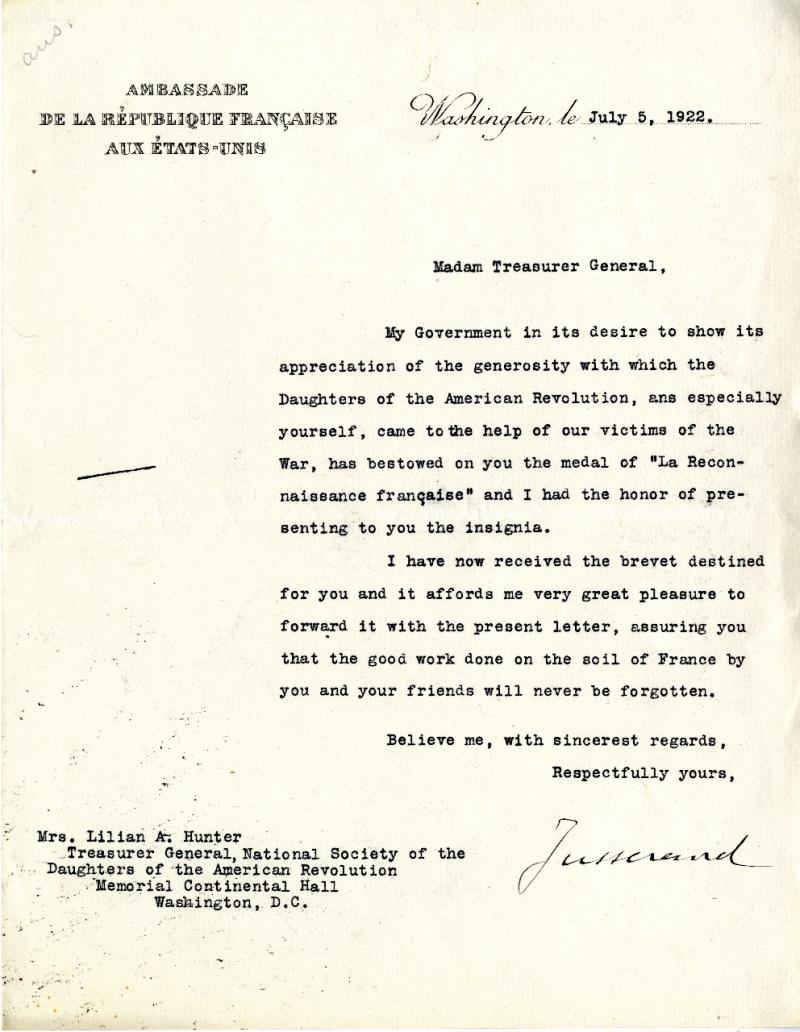
DAR Serves Its Country
The NSDAR was an essential partner to the American Red Cross during the Great War. DAR members not only formed Red Cross auxiliary chapters in their communities, but also joined the Red Cross as nurses, training and traveling abroad to serve. Approximately 260 DAR members went abroad to perform war service; an additional 125 DAR members enlisted but were not called to serve. With organizations such as the Red Cross and the YWCA, Daughters worked in hospitals, canteens, and recreation huts. While the majority of the members served as nurses, others served as motor corps drivers, casualty searchers, canteen workers, stenographers, and entertainers. The majority of the women were stationed in France; however, some went to England, Italy, Turkey, Greece, Siberia, and even Germany. The expenses to go abroad were in many cases covered by state societies and individual chapters.
DAR Serves Its Country
Most of the DAR members’ initial nursing training began with their Red Cross auxiliary chapters. Besides knitting and sewing, the Daughters took the lead in training members and others within their communities in first aid and other aspects of nursing. In a DAR magazine article from December 1917, “Training for Nursing, A Patriotic Opportunity,” author, Elizabeth McCracken, explained how a nurse is “…first of all, a woman of fine character, good education, a sound physique, who has had three years intensive training in a hospital.” A shortage of nurses was a real possibility if more women did not sign up for training as soon as possible. McCracken likened young women going to hospital training schools to the young men going to West Point or Annapolis – both were filling in for their seniors, serving as they trained. She continued:
It would seem to be a fitting thing that, among the young women who avail themselves of this opportunity there should be many Daughters of the American Revolution. Theirs is a special inheritance of patriotic desire and achievement… they have a personal, particular inspiration to abide by the old motto, ‘Noblesse oblige.’
On display: Photograph of the Mercy Warren Chapter (MA) attending an all-day meeting of the War Relief Service Committee for Red Cross work, 1919. (NSDAR Archives)
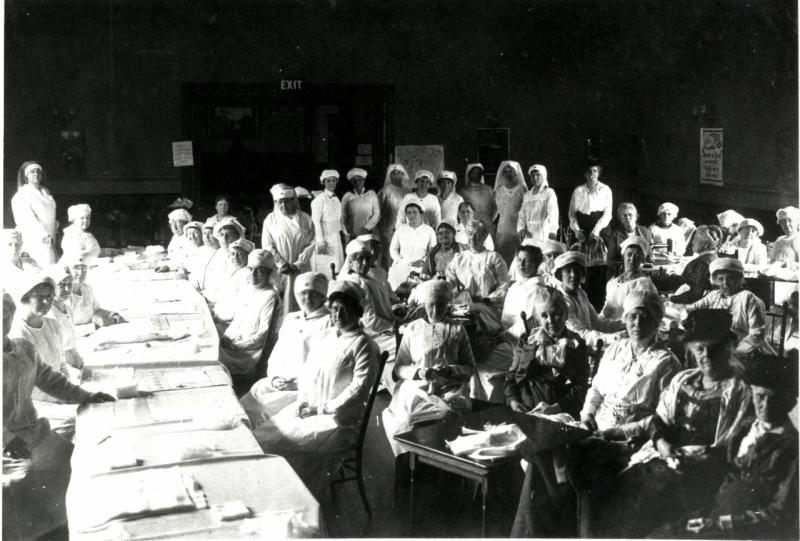
DAR Serves Its Country
On display: Photograph of the Letitia Green Stevenson Chapter knitting and mending garments for the Red Cross, from the Letitia Green Stevenson Chapter (IL) Scrapbook, 1918. (NSDAR Archives)
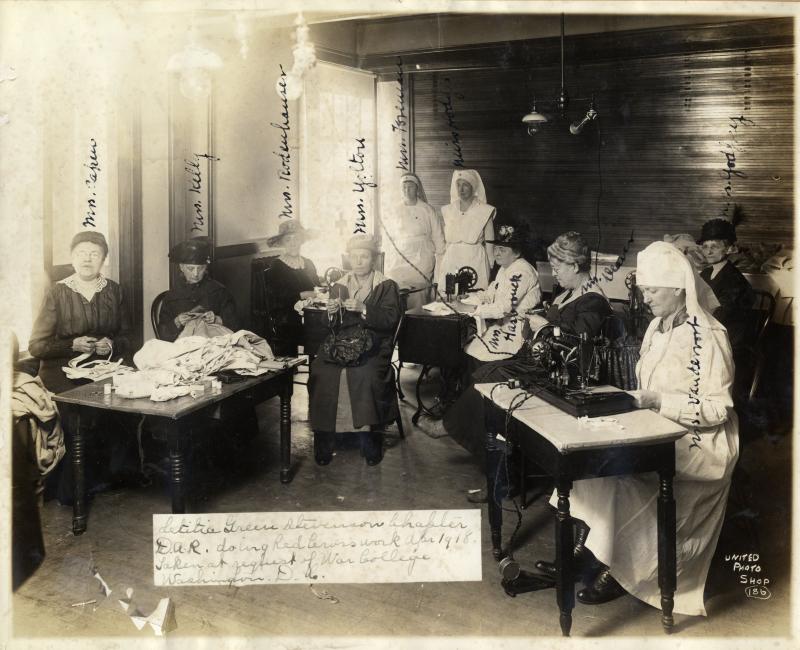
DAR Serves Its Country
On display: Photograph of the Sakakawea Chapter (ND), circa 1918. (NSDAR Archives)
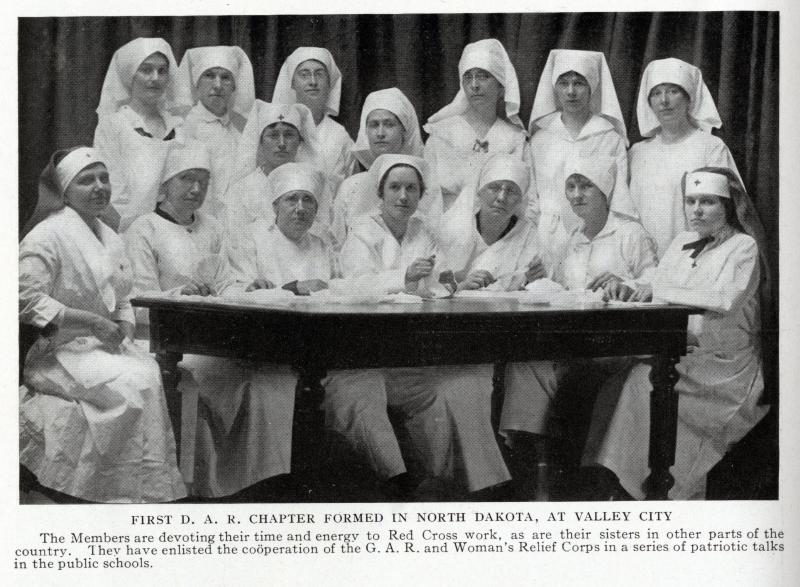
DAR Serves Its Country
On display: Photograph of the Chicago Chapter (IL), circa 1918. (NSDAR Archives)
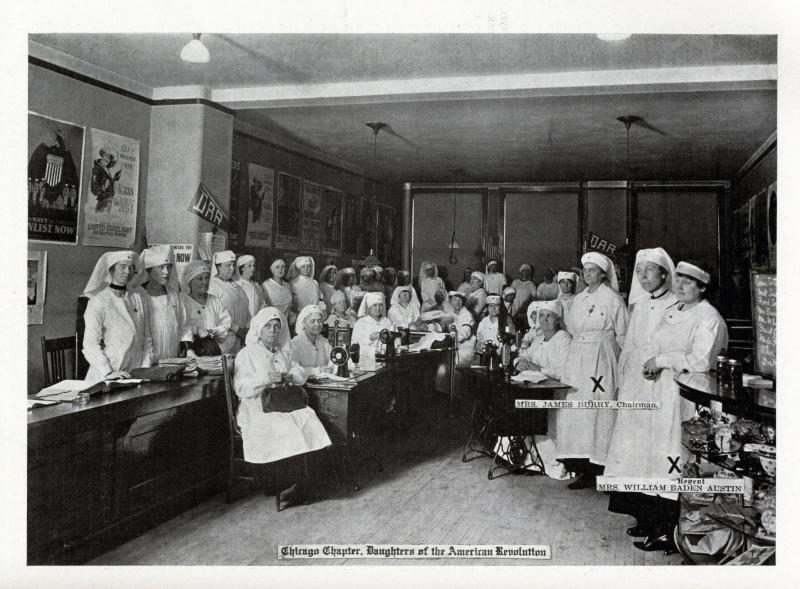
DAR Serves Its Country
“Conditions here are war conditions. Our unit came equipped to take care of 500 beds; they have 950… Though they [the nurses] are doing double work, those whom I met took their duties with the good-nature and enthusiasm that one would only expect from an American contingent.” DAR magazine, September 1917
On display: Red Cross pin, circa 1910 (NSDAR Archives)
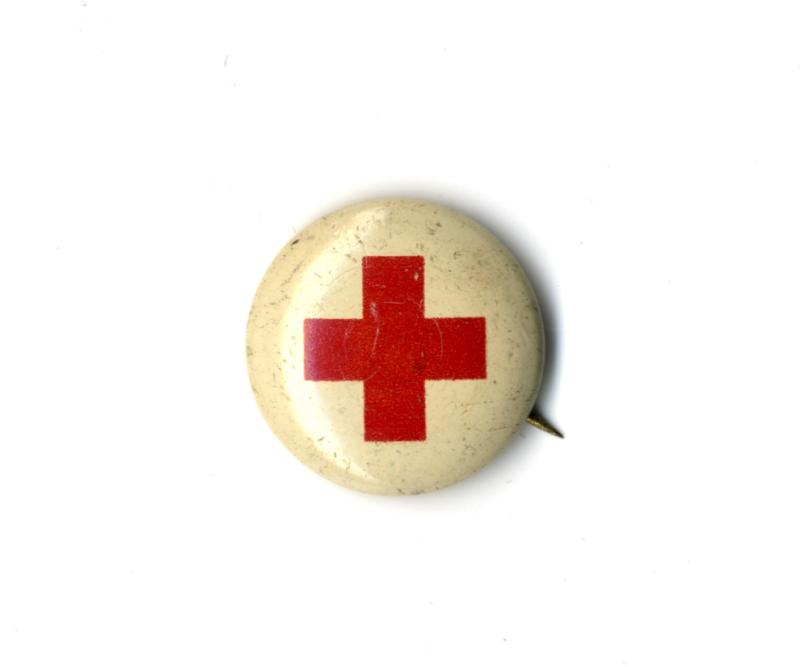
DAR Serves Its Country
Alice Cunningham Rogers of the Putnam Hill Chapter (CT) was appointed Secretary of the National War Work Council of the YMCA of the U.S. in service with the troops of the American Expeditionary Force in France. She organized canteens at the front lines in France. On March 21, 1919, she died at Neuilly, France, while rendering a noble service for her country and humanity.
On display: Report of War Work of the Daughters of the American Revolution in Connecticut during the Great World War from August 15, 1914 – November 11, 1918, compiled by Elizabeth Barney Buel, State Regent, 1919. Alice Cunningham Rogers is listed on page 13. (NSDAR Archives)
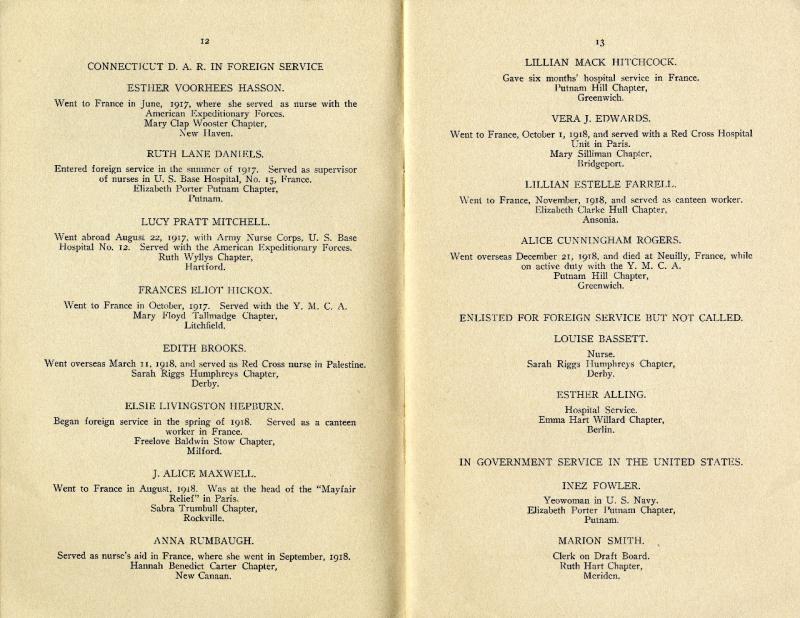
DAR Serves Its Country
Anne Penland of the Edward Buncombe Chapter (NC) was a nurse anesthetist and instructor at the Presbyterian Hospital of New York Unit, Base Hospital Number 2. She was the first U.S. nurse anesthetist to go officially to the British front, where she won the confidence of British medical officers. Due to Ms. Penland’s influence, the British decided to train their own nurses in anesthesia, ultimately relieving more than 100 physicians for other medical and surgical work.
While serving in a casualty clearing station close to the front in Flanders, Belgium, Ms. Penland wrote in her diary, “It is a glorious thing to give one’s life for one’s country, but how unutterably sad; such numbers of lives being sacrificed in a strange land with no loved ones there. What grief and agony to those waiting at home!”
On display: Passport photograph of Anne Penland, circa 1917. (Edward Buncombe Chapter)
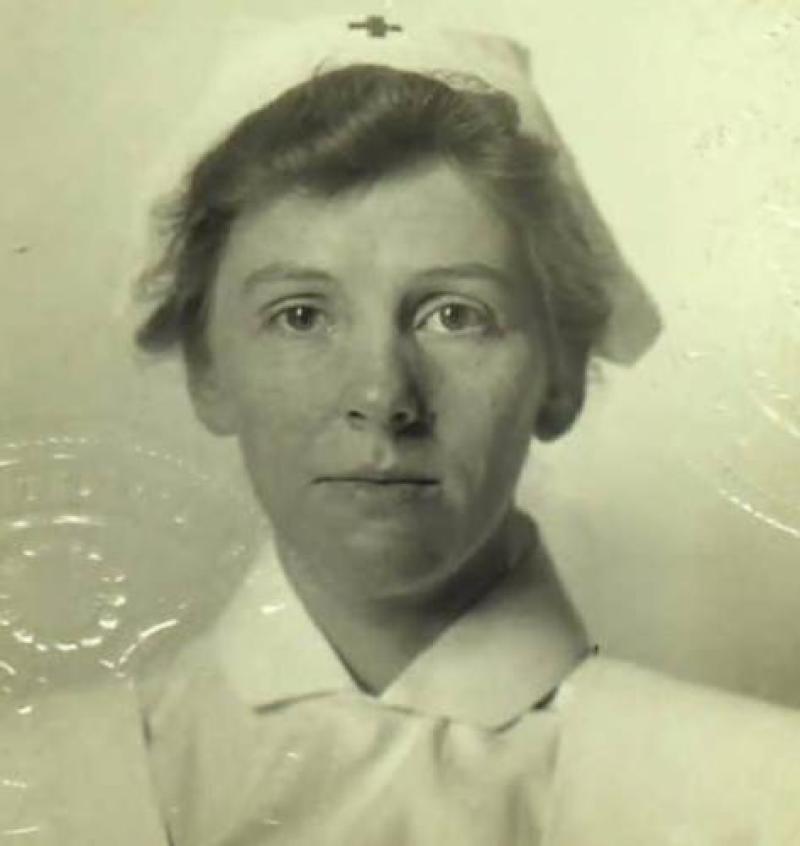
DAR Serves Its Country
Emma Gene Wensel Venn, a member of the Natchez Chapter (MS) and a Red Cross searcher, was responsible searching for men who were not accounted for and labeled as “missing.” She visited sick or wounded men in various base hospitals to obtain first-hand accounts of what they saw. The reports were then sent to headquarters before contacting the relatives of the missing men.
In a letter to her mother, Mrs. Venn wrote:
I have seen and talked with some of our United States wounded, a train load of them – one poor fellow had been gassed. I do not think there was a dry eye among us that train passed – wounded, but smiling – the smile of bashful boys, who are being praised, that’s the way they looked to me, and with a tiny ‘Stars and Stripes’ at every bed-side, at every window. How can men stay home – how can they…And I was glad, mother dear, and proud, too, that you did not treat my desire to come lightly, or oppose me.
While on active duty in France, Mrs. Venn was stricken with influenza and died on October 26, 1918.
On display: Photograph of the Natchez Chapter (MS) at Dunleith, the historic home of Agnes Carpenter, March 1918. Emma Gene Venn is on the right, sitting behind the post. (NSDAR Archives)
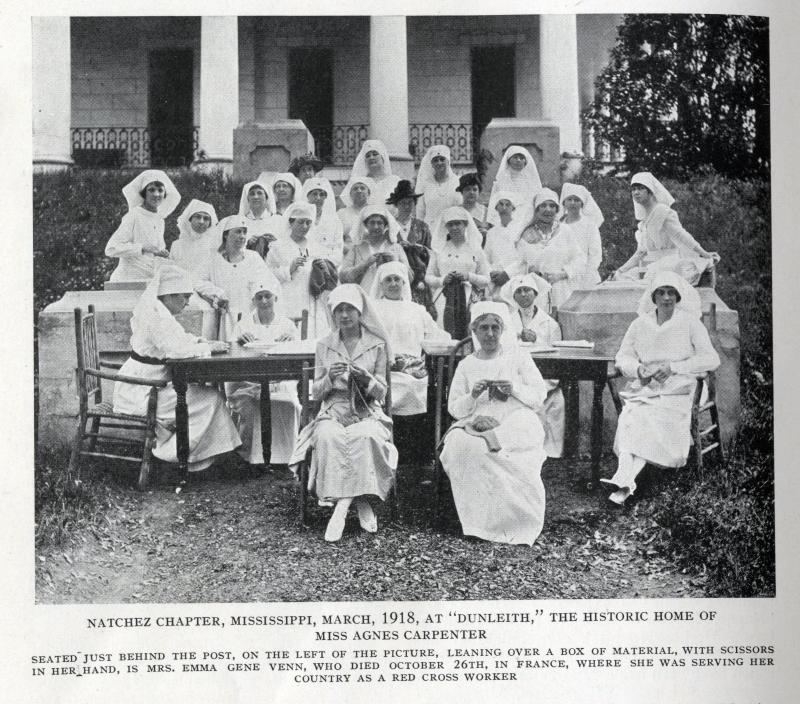
DAR Serves Its Country
Jane A. Delano of the Judge Lynn Chapter (DC) was the Director General of the Department of Nursing of the American Red Cross and recruited nearly 25,000 nurses during the war. She managed the administration of the overseas nursing operation and designed an expanded postwar domestic Red Cross nursing program. Recognized for her honorable achievements throughout her nursing career, Miss Delano was decorated by President William H. Taft on behalf of the Red Cross, the Japanese and Greek Governments, and the American Institute for Social Science. She was awarded posthumously the Distinguished Service Medal by Secretary of War Newton D. Baker.
Miss Delano passed away from an ear infection on April 15, 1919 at a base hospital in Savenay, France after returning to France to investigate health conditions after the armistice was signed. Her last words were, “I must get back to my work.” She was given a military funeral and interred at Arlington National Cemetery. A memorial service was held in Memorial Continental Hall and tributes to her were read from all parts of the world.
On display: Photograph of Jane A. Delano of the Judge Lynn Chapter (DC) with a group of her nurses before going to Europe, circa 1914. (NSDAR Archives)
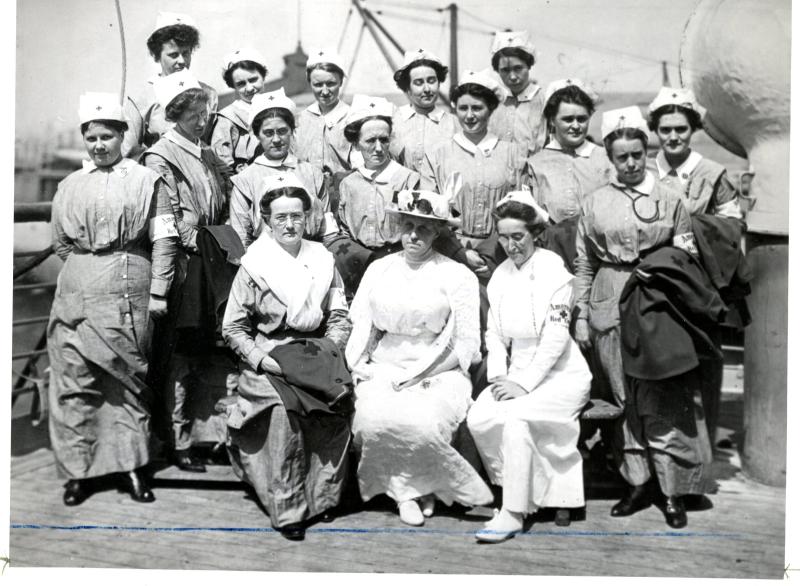
DAR Serves Its Country
On display: American Red Cross Textbook on Home Hygiene and Care of the Sick, by Jane A. Delano and Anne Hervey Strong, 1918. (NSDAR Archives)
